
by Polina Yan
Getting approved for standard payment processing isn’t always straightforward. Some businesses face higher risks due to industry regulations, increased chargeback rates, or fraud concerns. Traditional payment processors often refuse to work with these businesses, leaving them with limited options for accepting online transactions. This is where high-risk payment processors come into play, offering specialized solutions that cater to industries with higher financial and regulatory complexities.
A high-risk payment processor is a provider that works with businesses considered too risky for traditional banks and merchant service providers. These processors ensure that companies in industries such as adult entertainment, gambling, CBD, forex trading, and subscription-based services can securely accept payments. They offer tailored fraud prevention, chargeback management, and compliance tools, allowing businesses to operate smoothly despite their classification.
For businesses operating in the mentioned industries, high-risk payment processing is not merely a choice but the obligatory requirement. Otherwise, the company will risk losing clients, sales, and reputation. Choosing the right high-risk payment gateway is the solution to secure transactions, compliance with the law, and the convenience of the payment process. Here is the review of the best high risk payment processors, what they are, and what to pay attention to while choosing the provider.
What Are High-Risk Payment Processors?
A high-risk processor is a merchant services company that deals in transaction processing services to merchants that banks and general merchant account providers will not service. These merchants are high risk due to the incidence of higher chargebacks, government regulation, or operating within a merchant category that is more vulnerable to fraud than others. As opposed to the usual merchant account that handles low-risk merchants with established transaction histories, high-risk processors are designed to handle unknown patterns of finance as well as increase security and anti-fraud protection.
| Processor | Best For / Industries Served | Key Strengths | Potential Limitations |
|---|
| PayKings | Adult, CBD, iGaming, international merchants | Customized accounts, fraud & chargeback protection, global reach | Higher fees for very high-risk industries |
| Durango Merchant Services | Tech support, subscriptions, debt collection | Customized risk-mitigation strategies, multi-currency support, fraud filtering | Longer approval times |
| Soar Payments | Tech support, e-commerce, travel, subscription models | Integrated fraud protection, recurring billing support, flexible payment models | Industry restrictions in some regions |
| Authorize.Net | High-risk e-commerce, businesses needing fraud tools | Advanced fraud protection (AVS, CVV), reliable gateway, trusted provider | Less flexible for newer high-risk sectors |
| NMI Payment Gateway | Businesses needing multi-platform support | Multi-merchant processing, 150+ shopping cart integrations, advanced reporting | Requires technical setup for customization |
| eMerchantBroker (EMB) | CBD, adult, online casinos, crypto merchants | Global presence, chargeback reduction, crypto support | Higher per-transaction fees |
| Scrile | Adult entertainment, coaching, subscription platforms, marketplaces | Fully custom integrations, multi-gateway support, PCI DSS compliance, fraud/chargeback management | Requires development partnership (not plug-and-play) |
Industries Considered High Risk

Certain sectors are automatically flagged as high risk due to their transaction patterns, regulatory challenges, or industry reputation. Some of the most common high-risk industries include:
- Adult entertainment – Subscription-based and pay-per-view adult content platforms often experience high refund and chargeback rates.
- CBD and cannabis – Despite legalization in many regions, CBD transactions remain highly regulated, making it difficult to find mainstream payment solutions.
- Gambling and online gaming – High transaction volumes and potential fraud risks make online casinos and sports betting platforms a challenge for traditional processors.
- Forex trading and cryptocurrency exchanges – These industries deal with volatile markets, high-value transactions, and strict financial regulations.
- Subscription services and recurring billing models – Businesses that rely on automatic renewals often face higher chargeback rates due to customers disputing charges they forgot about or didn’t authorize.
Why Businesses Need High-Risk Payment Processing
For high-risk businesses, it is important to identify a reliable high-risk payment processor. One of the most significant issues is chargeback management—when the customers dispute transactions, excessive chargebacks can lead to the cancellation of accounts. A high-risk processing expert offers solutions to prevent, track, and dispute chargebacks before they disrupt business operations.
Another priority is security. There are higher levels of fraudulent charges in high-risk industries and therefore high-risk processors will need to implement advanced fraud detection systems and encryption methods to protect businesses and their customers. Compliance with industry regulations—such as anti-money laundering law and finance report mandates—requires the services of a high-risk payment processing provider that is experienced in navigating intricate legal systems and offers compliance-oriented services.
Without an appropriate high-risk payment processor, businesses are unable to process payments, leading to missed sales and frustrated customers. An appropriate provider ensures secure transactions, regulatory compliance, and financial viability in the long term.
How High-Risk Payment Processing Works

Businesses categorized as high risk require specialized high-risk payment processing to handle transactions securely. Unlike standard merchant accounts, these businesses need solutions that account for chargeback risks, fraud prevention, and industry-specific regulations. A high-risk payment gateway plays a crucial role in ensuring smooth transactions while minimizing potential financial threats.
Merchant Account Setup
To be able to make the payments, high-risk businesses need to set up a high-risk merchant account. The high-risk merchant account is set up to accommodate businesses that have a higher rate of chargebacks, including adult entertainment, subscription-based services, and internet gambling. The merchant account serves as the intermediary between the bank, payment gateway, and the business to process the transaction approval and settlement in the correct manner.
High-risk accounts differ from regular merchant accounts in that they usually have higher processing rates because of the greater risk banks and payment processors take on. But they provide greater flexibility in that businesses can process payments that would be denied by ordinary providers.
Approval Process for High-Risk Businesses
Getting approved for a high-risk payment gateway involves a more extensive review than a standard merchant account. Payment processors evaluate several factors before approving a business, including:
- Industry type – Businesses in sectors prone to fraud or regulation-heavy industries face stricter scrutiny.
- Transaction history – A company with a history of excessive chargebacks may struggle to find a suitable processor.
- Financial stability – Payment processors assess a company’s financial health, ensuring it can manage refunds, chargebacks, and fees.
- Compliance and security measures – Businesses must demonstrate adherence to legal requirements, such as PCI DSS compliance.
Risk Mitigation in High-Risk Payment Processing
Since high-risk industries have more fraud and disputes, high-risk payment options include more advanced fraud detection, encryption, and chargeback protection. The majority of the payment processors use AI-based fraud prevention tools to detect unusual transaction behavior and mark it as suspicious. The chargeback protection services also make it possible to lower losses since it allows businesses to dispute false claims and catch repeated transaction issues.
A high-risk gateway offers the facility to make secure payments while protecting the businesses from risks to their finances, the law, and continuity of business.
Best High-Risk Payment Processors in 2026
Finding the right high-risk merchant processor is essential for businesses facing payment restrictions due to industry classification. Some providers specialize in handling businesses with frequent chargebacks, regulatory concerns, and fraud risks. Below, we break down some of the best high-risk payment processors and gateways that offer secure and reliable transaction solutions.
PayKings
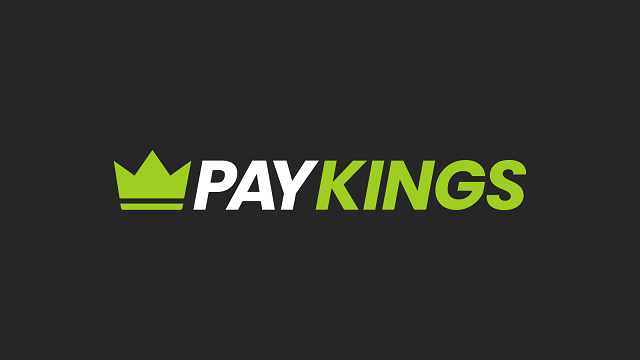
PayKings is a highly reputable high-risk merchant processor that provides customized merchant accounts to adult entertainment, CBD, and iGaming businesses and other industries. It offers fraud protection services, chargeback protection features, and seamless integration with numerous gateways of payment. The company also supports business entities from restricted regions, making it the best choice for international high-risk merchants.
Durango Merchant Services
Durango deals with high-risk businesses that have high probability of chargebacks, like tech support businesses, subscription-based companies, and debt collection agencies. Durango’s unique selling point is that it is able to offer customized account management so that businesses are able to create risk-mitigation strategies. Its high-risk payment processing services encompass multi-currency processing and fraud filtering to enable secure transactions in high-risk businesses.
Soar Payments
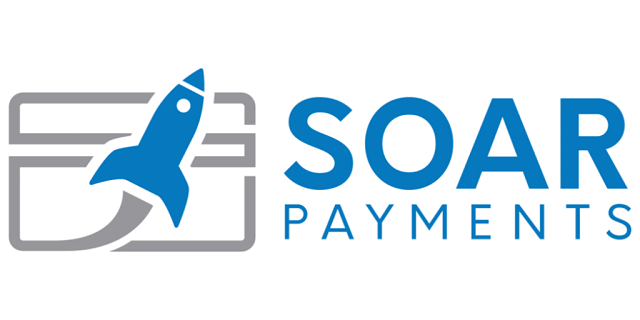
Soar Payments is the perfect choice for tech support, e-commerce, and travel businesses that experience numerous chargebacks. With the firm’s full-integrated fraud protection features, the company is able to process payments while minimizing risks. With its support of numerous models of payments like one-time buy and recurring billing, Soar Payments is perfect for businesses that sell subscription models.
Authorize.Net
Authorize.Net is one of the trusted and veteran players in the payment processing business that targets businesses that need advanced fraud protection. As a high-risk gateway payment processor, it offers secure transaction processing and services such as address verification services (AVS) and card code verification (CVV). Mostly, businesses that experience multiple fraudulent transactions utilize its advanced protection features to process secure payments over the internet.
NMI Payment Gateway
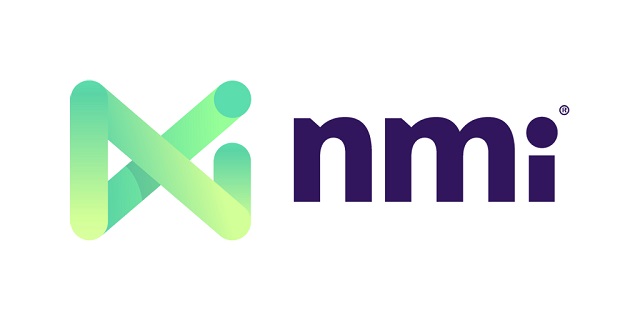
NMI is a highly flexible high-risk processing solution that allows businesses to customize their payment integration. With features like multi-merchant processing, advanced reporting, and compatibility with over 150 shopping carts, NMI offers a scalable gateway that adapts to unique business needs. It is particularly useful for businesses with complex payment structures or those needing multi-platform support.
eMerchantBroker (EMB)
EMB is also an international high-risk merchant processor that provides solutions to CBD, adult, and online casino businesses. It provides tailored fraud protection, chargeback reduction programs, and other payment solutions, including support for cryptocurrency. Due to EMB’s global presence, it is ideal for companies that must go global while providing secure transactions.
Factors to Consider When Choosing a High-Risk Processor
Choosing the correct high-risk processor involves a very close examination of some very key factors. High-risk payment processors differ from standard payment providers because they have higher fees and provide specialized services for fraud, chargeback, and compliance.
Some of the largest issues are transaction fees and rates. Due to the higher risk of fraud and chargebacks, higher-risk processors generally cost more, in the range of 3% to 10% per transaction. Companies will then have to weigh up the benefits of the specialist provider against the cost.
High-risk processors also vary widely in chargeback policies. Some include chargeback prevention features, while others offer dispute assistance. A good chargeback management is what the ideal high-risk processor should possess to minimize the loss of finance.
For companies operating internationally, global payment support is essential. The ability to accept multiple currencies and process payments across different regions ensures scalability and market expansion.
Lastly, integration and security should not be overlooked. The best high-risk payment solutions provide robust API support, end-to-end encryption, and fraud detection to keep transactions secure while ensuring a seamless user experience.
Why Scrile is the Best Choice for High-Risk Payment Processing
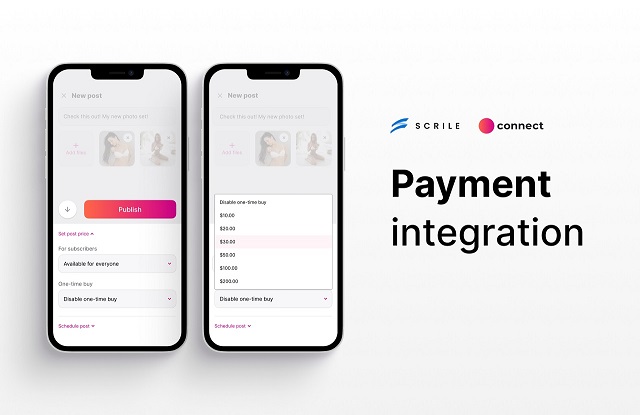
Finding the right high-risk payment solutions can be challenging, especially for businesses operating in restricted industries. Unlike generic providers, Scrile high risk payment processors offer tailored integrations designed to meet the specific needs of high-risk businesses.
Custom Solutions for High-Risk Industries
Scrile understands that every business has unique payment processing requirements. Instead of offering a one-size-fits-all approach, it provides custom high-risk payment processing integrations that align with different business models. Whether a company operates a subscription-based service, an online marketplace, or an adult entertainment platform, Scrile develops solutions that ensure seamless transactions and long-term reliability.
Industry-Specific Expertise
Many payment processors avoid working with businesses in industries like gaming, adult services, and high-risk e-commerce. Scrile specializes in these sectors, offering payment gateway integrations that support multi-currency transactions, fraud detection, and chargeback management. This expertise helps businesses avoid sudden account freezes or rejected payments, ensuring smooth financial operations.
Scalability and Compliance
Growing businesses need a payment solution that can scale with them. Scrile integrates PCI DSS-compliant security measures, advanced fraud prevention tools, and compliance support for international payments. This ensures that businesses can expand into new markets without facing regulatory roadblocks.
Seamless Integration with Multiple Payment Gateways
Unlike many high-risk payment processors that offer limited integration options, Scrile works with multiple high-risk payment solutions to provide businesses with flexibility. Whether using Stripe, PayKings, or custom-built payment systems, Scrile ensures full compatibility with existing platforms, making transactions more secure and efficient.
Conclusion
Selecting the right high-risk payment processors is essential for security, compliance, and smooth financial operations. Businesses in high-risk industries need reliable solutions that prevent fraud, reduce chargebacks, and ensure seamless transactions. Explore Scrile’s custom payment integration services to build a secure, scalable system tailored to your business needs. Strengthen your payment processing today with a trusted partner.
Polina Yan is a Technical Writer and Product Marketing Manager, specializing in helping creators launch personalized content monetization platforms. With over five years of experience writing and promoting content, Polina covers topics such as content monetization, social media strategies, digital marketing, and online business in adult industry. Her work empowers online entrepreneurs and creators to navigate the digital world with confidence and achieve their goals.

by Polina Yan
Scan a T-shirt. Watch it move. Trigger a sound. Unlock a message. Augmented reality is already sewn into fabric, printed on hoodies, embedded in patches. It’s not hype. It’s already out there — and it works.
The question now is simple: how to make augmented reality clothing that doesn’t feel like a cheap trick. Something that sticks. Something people want to wear, share, and come back to.
Designers are experimenting with motion graphics on sleeves. Educators use AR shirts to show anatomy in real time. Streetwear drops go viral because a camera reveals something the naked eye can’t. These aren’t concepts. They’re products in the wild.
This article breaks it down. The gear you need. The process, step by step. How brands are doing it. What’s actually worth building. And how anyone with a strong idea — not just major labels — can start putting interactive clothing into the world.
What Is Augmented Reality Clothing?
Augmented reality clothing refers to garments that trigger digital visuals or interactions when viewed through a phone or AR glasses. It could be an animation mapped to a printed design, a video layered on a logo, or 3D content that appears to hover just above the fabric.
The experience depends on how the garment is designed. Some respond to image markers or patterns, others use QR codes or embedded chips. Once scanned, they activate extra content: moving graphics, audio, virtual buttons, or full-screen scenes. It’s a way to add motion and story to physical products without screens.
Augmented reality try on clothes refers to digital fitting tools that let users preview how a garment might look, often using a mobile camera or smart mirror. Meanwhile, augmented reality clothing fitting uses body tracking and virtual overlays to simulate real-time fit, helping shoppers make better decisions without needing a physical fitting room.
This technology blends novelty with function. It helps brands turn clothing into interactive media. Artists use it to create immersive installations. Educators apply it to visualize anatomy, geography, or science in classrooms. For independent creators, it opens a way to sell not just fabric, but digital storytelling through clothing.
Real-World Use
Fashion retailers are already testing and deploying AR at scale. H&M launched AR try-ons through Snapchat, allowing users to select and preview outfits directly through their phones.
Other examples include:
- Music merch that unlocks unreleased tracks
- Event tees that act as digital passes or memory vaults
- Kids’ clothing that tells interactive stories
- Collectible drops tied to NFTs or limited-edition content
AR adds a second layer to clothing. It gives people a reason to look again — not just wear it once and forget.
The Tech Behind AR Clothing

Before anything looks cool through a camera, it has to be built right. How to make augmented reality clothing depends on a few moving parts: visuals, markers, motion tracking, and the software that ties it all together.
Start with design. Most creators use 3D modeling tools like Blender or Marvelous Designer to shape digital garments or visual elements. These can range from simple pop-up text to full characters animated over the shirt.
Then comes delivery. There are two main approaches:
- Marker-based AR: A printed image or logo on the garment triggers the digital layer. This is the most common approach for T-shirts and jackets.
- Markerless AR: The app tracks the body or clothing without needing a printed reference. It’s trickier to build but creates a smoother experience.
To keep the visual stable while the person moves, the system uses AI tracking. That includes face and body detection, pose estimation, and sometimes depth mapping. These tools help the content stay “stuck” to the right part of the garment.
Apps come in two formats:
- WebAR: Runs directly in the browser. No download needed. Easier to access, but with some performance limits.
- Native mobile apps: More powerful and smoother but require users to install something.
Platforms like Unity, 8thWall, Vuforia, and Spark AR handle the development layer. Each has different strengths. For example, Spark is popular for filters, while Unity gives full control over interaction and animation. This is where your augmented reality clothing app takes shape.
From Fabric to Framework
To connect real garments with digital content, creators use:
- QR codes stitched into tags or labels
- Printed markers blended into the graphic design
- Image recognition that links a shirt’s design to a hidden animation
- Digital twins, where each physical item has a virtual copy
These methods are what turn regular AR clothes into experiences. Whether you’re building immersive merch, educational tools, or virtual reality clothing, everything starts with a decision: what does the shirt unlock, and how does it know when to do it?
Step-by-Step: How to Make Augmented Reality Clothing

Creating an interactive garment looks complex from the outside, but the workflow becomes clear once you break it into stages. Anyone exploring how to make augmented reality clothing will follow a path that moves from concept to design and then into development, testing, and launch. Each step shapes the final feel of the product.
Step 1 — Define Your Concept
Start with a simple question: what should the clothing activate? Some creators build story-driven animations. Others focus on music, product information, or collectibles. The concept guides the style of the artwork, the type of animation, and the platform you will use. It also helps identify the audience. Kids, festival-goers, sports fans, or educators respond to very different visual cues. A clear direction keeps the project from drifting.
Step 2 — Design the Garment
The physical item needs to work with the digital layer. Choose a spot for the trigger image that stays visible when the garment is worn. That spot might be the chest, sleeve, or back panel. A detailed illustration, logo, or symbol often works best because it gives the tracking system enough information to lock onto. Think of the design as a stage: clean shapes help the camera recognize the target quickly.
Step 3 — Choose the Platform
The engine you select shapes the development process. Unity is popular for animated scenes with movement and depth. WebAR tools allow users to scan garments without installing an app. Meta Spark works well for camera-first experiences shared on social networks. Each option has its own workflow, so it’s best to match the tool to your idea rather than forcing the idea into the tool.
Step 4 — Build the Digital Layer
This is where the visual content takes form. It can be a short animation, a looping 3D object, a sound-reactive graphic, or a simple text reveal. The digital layer should enhance the design rather than overwhelm it. Clear timing, readable motion, and smooth interaction give the effect depth without confusing the user.
Step 5 — Link the Content
After the animation is ready, connect it to the chosen marker. Platforms offer tools that map digital visuals onto an image so the scene appears in the right place every time. Good alignment is essential. Poor mapping makes the AR look shaky.
Step 6 — Test Across Devices
Phones differ in camera quality and performance. Test on as many devices as possible. Check tracking stability, lighting conditions, and how the AR reacts when the person moves or turns.
Step 7 — Launch and Promote
Once everything feels solid, release the product. Share demos, record try-on clips, create hashtags, and encourage your community to post their reactions. AR clothing spreads fast because people enjoy showing it off.
AR Clothing Brand Examples and Ideas
There’s no shortage of real brands proving that AR clothing isn’t a gimmick — it’s a tool that gets attention, tells stories, and drives engagement. If you’re serious about how to make augmented reality clothing, it helps to study what others have already done and why it worked.
Here are a few standout examples from both big players and smaller experiments:
- H&M ran AR try-ons through Snapchat. Pick an outfit, open your camera, see it mapped on your body. It worked inside the app and on the H&M website. No extra hardware. No separate app. Just scroll, scan, and try.
- Red Bull dropped shirts that launch interactive games. You scan the chest print, it opens a branded AR scene with characters, effects, movement — all tied into their “Wiiings” campaign. Merch became the controller.
- Pepsi used AR on bottles and apparel. Some shirts unlocked video messages. Others worked as part of limited-edition drops tied to music events.
- Zalando took the sizing headache and turned it into an AR preview. You could stand in front of your phone and check how a jacket fits. It didn’t just show the product — it helped you decide.
- IKEA went heavy on product AR, then let that same idea spill into branded clothing and displays. The logic was the same: place the thing in your space. Let people imagine owning it before they buy.
- Artists are doing this too. Shirts that show moving sculptures. Logos that turn into faces. Generative graphics triggered by your camera.
- Some creators are pairing this with NFTs. The shirt is real, but the AR layer is a digital twin with unlockable perks.
If you’re thinking about how to make augmented reality clothing, don’t just chase effects. Figure out what the shirt gives people once they scan it.
Build Your Own AR Fashion Brand

The tech matters, but the branding decides whether anyone cares. A clean marker won’t save a weak idea. People remember how something looks, feels, and moves — both in their hands and through their camera.
Start with your visual identity. Your logo, colors, graphic style — all of it has to read clearly in print and on screen. Some designs break apart once scanned. Fine lines blur. Busy backgrounds confuse trackers. Design with contrast. Test at different sizes. Hold the shirt up to a camera and move it around. If the AR effect only works when the shirt is perfectly still, fix it.
The user experience goes beyond what the app shows. Think about lighting. Think about front-facing vs. rear cameras. Make sure your content works on both high-end and older phones. Not everyone scans your work with a brand-new iPhone. The real world is messy. Build for it.
Now: how do you sell it?
You don’t need to launch with 30 pieces. A single strong design, dropped in a small run, can do more than a full collection. Start with a theme. Tie it to a moment, a message, or a story. Offer it in a limited batch. Set up a basic online store or collaborate with a brand that already has reach.
AR gives you room to do things printed clothing can’t. That’s your edge. Don’t waste it with empty effects. Let the shirt unlock something worth coming back for. A visual. A sound. A memory. A reason to care.
Develop Your Own AR Product with Scrile Custom Development Services

Building something that actually works takes more than a template. You need a team that understands how to turn your concept into a full product — not just an effect. That’s where Scrile comes in.
Scrile isn’t a platform. It’s a custom development service. That means you don’t adapt your idea to a preset tool. We build the tool around your idea.
If you’re serious about how to make augmented reality clothing, and you’re ready to move from a test file to a live product, this is the stage to get in touch.
Here’s what Scrile can develop for you:
- Virtual try-on apps that simulate fit and style using body tracking
- Marker-based AR clothing systems that trigger animations, games, or product info
- Backends for AR commerce, including user analytics, content control, product syncing, and real-time data
- Admin tools for managing drops, updating designs, and tracking campaign performance
- Custom viewer interfaces — browser-based, app-integrated, or branded standalone
You bring the visual direction, the brand story, or even just a rough sketch. Scrile handles the architecture, the integrations, and the features needed to bring it to life.
We don’t offer one-size-fits-all packages. Every build is shaped around your goals, your stack, and your users. Whether you need a lightweight demo or a full ecosystem ready to scale, we work with you to make it happen.
Interactive clothing deserves interactive thinking. If the idea is ready, Scrile’s the partner that knows how to build it right.
Conclusion
AR clothing is functional design with digital depth. It’s built to be scanned, moved through space, and talked about. Every piece becomes more than its print. It becomes part of the story you’re telling.
Anyone with a clear vision can start building. The tools are out there. The workflow is manageable. What matters is choosing the right team to put the parts together and make sure it works where it counts — in someone’s hands, through their lens, on their screen.
Scrile builds full custom systems for interactive products like AR clothing. From visual triggers to app frameworks, from backend logic to user experience — everything is built to match your idea, not restrict it.
You can launch a working product, bring it to market, and grow it into something bigger. Start by exploring how Scrile Custom Development Services can help you build a real AR product from the ground up.
FAQ
How do you make an AR T-shirt?
Start with a clear idea. Decide what the shirt should trigger — animation, sound, video, or something else. Design the graphic so it works as a visual marker. Tools like Unity or WebAR platforms let you build the digital content and link it to the image. Test it on multiple devices. Once everything tracks smoothly, publish it and share your launch with the audience you’re building for.
Does H&M use AR in their clothing?
Yes. H&M partnered with Snap to create AR try-on experiences. Users can select clothes, see how they fit, and share the look, all through their phone’s camera. It works in both the Snapchat app and the H&M mobile app.
What companies are using AR for branding or clothing?
Brands like Red Bull, Pepsi, IKEA, Zalando, Philips, Walmart, and even Arsenal FC use AR in different ways — from merch drops and product previews to interactive ads and digital collectibles.
Polina Yan is a Technical Writer and Product Marketing Manager, specializing in helping creators launch personalized content monetization platforms. With over five years of experience writing and promoting content, Polina covers topics such as content monetization, social media strategies, digital marketing, and online business in adult industry. Her work empowers online entrepreneurs and creators to navigate the digital world with confidence and achieve their goals.
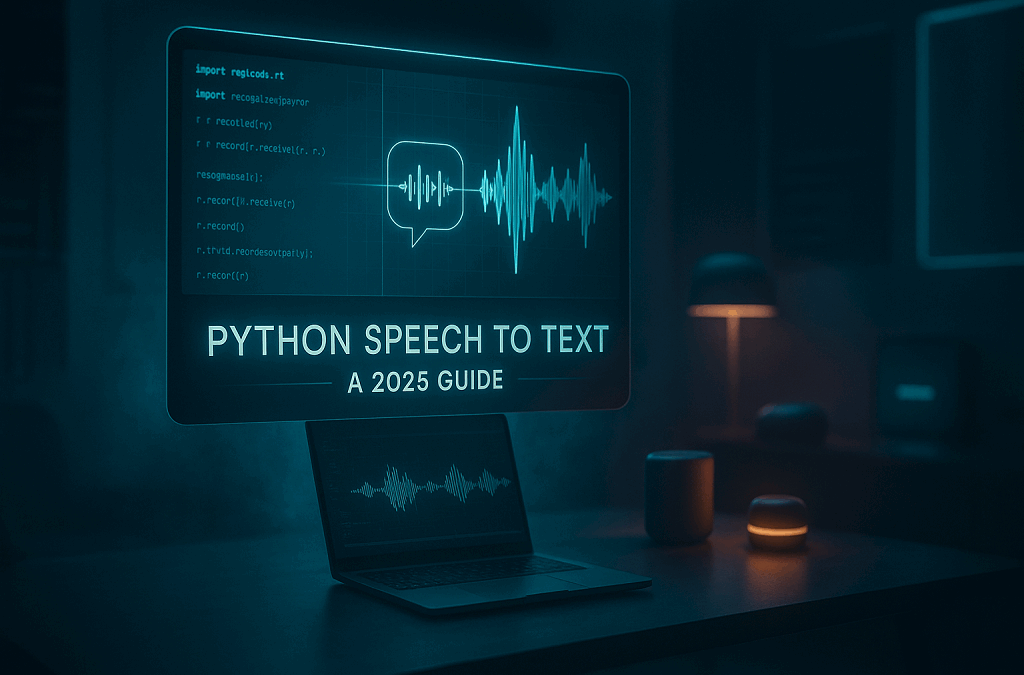
by Polina Yan
People talk to their devices every day — asking for directions, dictating notes, or letting an app transcribe a meeting. None of that feels unusual anymore. What makes it work under the hood is speech recognition, and in the developer world it often comes down to python speech to text. With a few open-source libraries and some smart models, spoken language can be turned into readable text in real time.
This article looks at the tools and methods that make it possible in 2026. We’ll cover the Python libraries most people start with, the role of deep learning in making recognition accurate, and the difference between running speech models offline or through cloud APIs. We’ll also look at real-world uses like streaming captions and business workflows, plus the option to build fully custom solutions when standard tools aren’t enough.
How Speech Recognition Works

Take any sound you make — it starts as vibrations in the air. A microphone catches them and slices the noise into tiny frames of data. The software then paints those pieces into a spectrogram, basically a picture showing which frequencies were strong at each moment. From there, the system tries to catch phonemes, the small sound units that build words.
Two brains are working together here: the acoustic model figures out which sounds you actually made, while the language model guesses what you probably meant in context. That’s how “recognize speech” doesn’t come out as “wreck a nice beach.”
What changed the game was machine learning. Hand-crafted rules and early statistical tricks couldn’t handle messy audio or accents. But once deep learning came in, accuracy jumped from rough 70% to well above 90%. Suddenly, voice typing on your laptop or phone didn’t feel like a gimmick anymore.
In practice the flow is:
- Record audio → slice it into frames
- Turn it into a spectrogram
- Match sound patterns with an acoustic model
- Let the language model form words and sentences
That mix of math, context, and neural nets is what makes speech recognition feel almost effortless today.
Popular Python Speech to Text Libraries

When diving into python speech to text, the library you choose shapes everything — accuracy, speed, cost, and whether you can even run your code offline. Let’s break down the most popular ones developers rely on in 2026.
| Library / Tool | Best For | Pros | Cons | Pricing / License |
|---|
| SpeechRecognition | Beginners, quick demos, class projects | Easy to use, works with multiple engines (Google, CMU Sphinx, etc.), minimal setup | Lower accuracy than deep learning models, limited customization | Open-source (MIT), free to use |
| Vosk | Offline apps, IoT devices, Raspberry Pi | Lightweight, runs on low-power devices, >20 languages supported | Models less accurate than Whisper, limited advanced features | Open-source (Apache 2.0), free |
| DeepSpeech / Coqui STT | Custom domain-specific transcription (e.g., medical, legal) | Trainable on custom datasets, full control over models, good accuracy | Requires GPU resources, setup is complex | Open-source (MPL 2.0), free |
| Whisper (OpenAI) | High-accuracy transcription, noisy audio, multilingual | Excellent accuracy, robust to accents/noisy input, dozens of languages | Heavy on resources, slower on CPU-only systems | Open-source (MIT), free; API pricing if using OpenAI’s hosted service |
SpeechRecognition
This library is often the first stop for newcomers. It’s easy to install, easy to use, and works out of the box with just a few lines of Python code. SpeechRecognition connects to different engines, including Google Web Speech API and CMU Sphinx for offline tasks. While it won’t deliver the same precision as heavy deep learning models, it’s perfect for quick demos, class projects, or small apps where setup speed matters more than accuracy.
Vosk
If you want python speech to text without depending on the cloud, Vosk is a strong option. It’s lightweight, efficient, and supports more than 20 languages. Developers often use it in Raspberry Pi projects, IoT devices, and mobile apps that can’t send constant requests to online servers. Vosk models are smaller compared to neural giants like Whisper, but that makes them fast, memory-friendly, and practical for real-world applications.
DeepSpeech and Coqui STT
Mozilla’s DeepSpeech introduced the idea of open-source deep learning for speech recognition, and Coqui STT now carries the torch. Both libraries use recurrent neural networks under the hood and can be fine-tuned with domain-specific data. That means if you’re building a medical or legal transcription tool, you can train the models to handle industry jargon. These projects require GPU power and patience, but the payoff is flexible, customizable models that you fully control.
Whisper (OpenAI)
Whisper is the current heavyweight among python voice to text tools. It supports dozens of languages, handles noisy or low-quality audio better than most alternatives, and shines in tasks like podcast transcription or video subtitling. It’s GPU-friendly, so running it locally is possible if you’ve got the hardware. The tradeoff is resource usage — Whisper is not as light as Vosk, but the accuracy gain is often worth it.
Choosing the Right Tool
Each library fits a different purpose. SpeechRecognition is great for quick wins, Vosk for offline apps, DeepSpeech/Coqui for custom training, and Whisper for cutting-edge accuracy. Your choice depends on whether you value simplicity, independence, or raw performance.
Speech to Text with Deep Learning
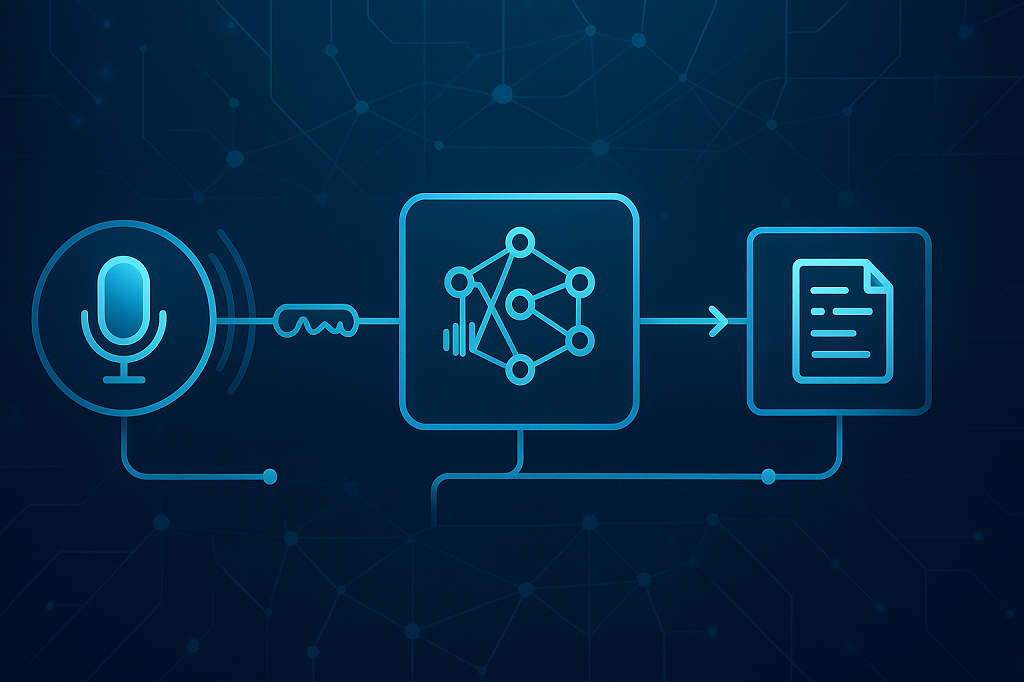
Before neural networks entered the field, speech recognition felt clunky — good for dictation, not much else. The last decade changed everything. Models got smarter, faster, and now speech can be converted into text in real time with surprising accuracy. That leap came directly from advances in speech to text deep learning.
Why Deep Learning Changed Everything
Traditional systems split speech recognition into multiple stages — signal processing, acoustic modeling, and language modeling. Deep learning stitched these parts together with end-to-end neural networks. Instead of engineers hand-tuning features, the network learns directly from massive datasets of audio and transcripts.
That shift boosted accuracy to levels once thought impossible. Real-time transcription is no longer just a demo feature — it’s reliable enough for live captioning, online meetings, and multilingual customer support. The models can adapt to different accents and background noise, making them practical outside the lab.
Frameworks & Models
Deep learning owes much of its momentum to powerful frameworks. TensorFlow and PyTorch dominate, offering developers tools to train, fine-tune, and deploy models. On top of these, pre-trained architectures like OpenAI’s Whisper and Facebook’s Wav2Vec2 set the bar for performance. Both use transformers — the same technology powering modern large language models — to recognize speech across dozens of languages.
In business, this technology is already everywhere: call centers use it to monitor conversations and analyze sentiment, while hospitals deploy it for medical transcription, saving doctors hours of manual note-taking.
The bottom line? Deep learning didn’t just make speech recognition better — it made it practical, flexible, and ready for scale.
Real-Time Speech to Text in Python
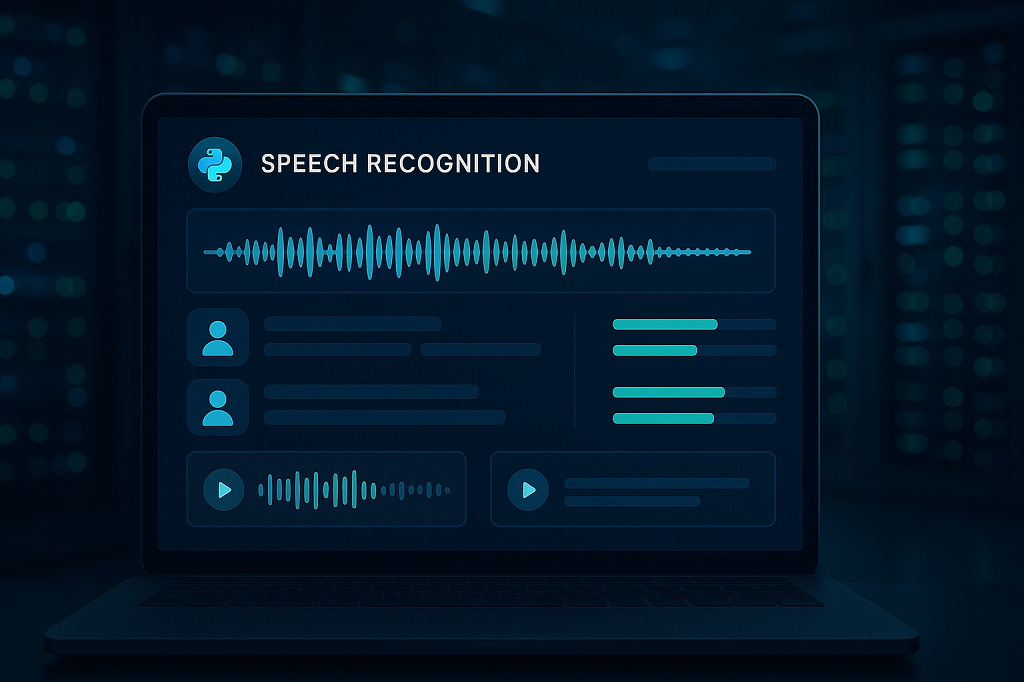
Turning spoken words into text while someone is still speaking is a different challenge from batch transcription. The main obstacle is speed: every millisecond counts. If a system lags, captions fall behind or chatbots respond awkwardly. Developers working with Python constantly wrestle with the balance between accuracy and latency.
Some of the most common use cases for real-time systems include:
- Live captioning for online events, classes, and conferences
- Streaming platforms where creators need instant subtitles
- Customer service bots that listen, process, and reply without noticeable delay
To make this work, Python libraries like Vosk and Whisper provide microphone input handling paired with WebSocket streaming. Audio chunks are captured, converted to features, and sent to a recognition model in near real time. The model then returns the text piece by piece, so the user never feels left behind.
Hardware matters just as much as code. GPU acceleration is key — it allows complex neural models to operate with only a fraction of a second of lag. That’s what transforms machine learning speech to text from a neat experiment into a dependable business tool.
When tuned correctly, these pipelines feel invisible. Users don’t think about the recognition layer at all; they just see accurate captions or get instant responses. That invisible layer is exactly what makes real-time transcription one of the most exciting areas of modern Python development.
Business Applications in 2026
Speech recognition is no longer a experimental functionality — it’s a business application in daily usage. Businesses of all types are employing speech recognition to reduce tedious work, facilitate communication, and deliver service to individuals.
Among its largest users are:
- Healthcare: doctors dictate medical notes while systems instantly generate structured records.
- Legal: courtrooms and law offices use dictation software for contracts and case transcripts.
- Media: podcasters and broadcasters add subtitles and searchable transcripts in minutes.
- Customer service: AI-powered call agents transcribe and analyze conversations to respond faster.
- Transcription providers: platforms offering human + AI blended services scale faster with automation.
The figures bear out the trend. According to Speech Technology Magazine, the speech technology market is expanding by double-digit percentages and is on course to top $50 billion by 2030, with firms making it simpler to implement machine learning frameworks, especially with cloud infrastructure.
The effect on businesses is simple: they save time keystroking and provide more convenient user experience to those who prefer or need voice interaction and make quicker decisions in real-time analytics. Whatever took a couple of hours of human effort is all achieved within a minute.
Scrile AI: Custom Speech to Text Development
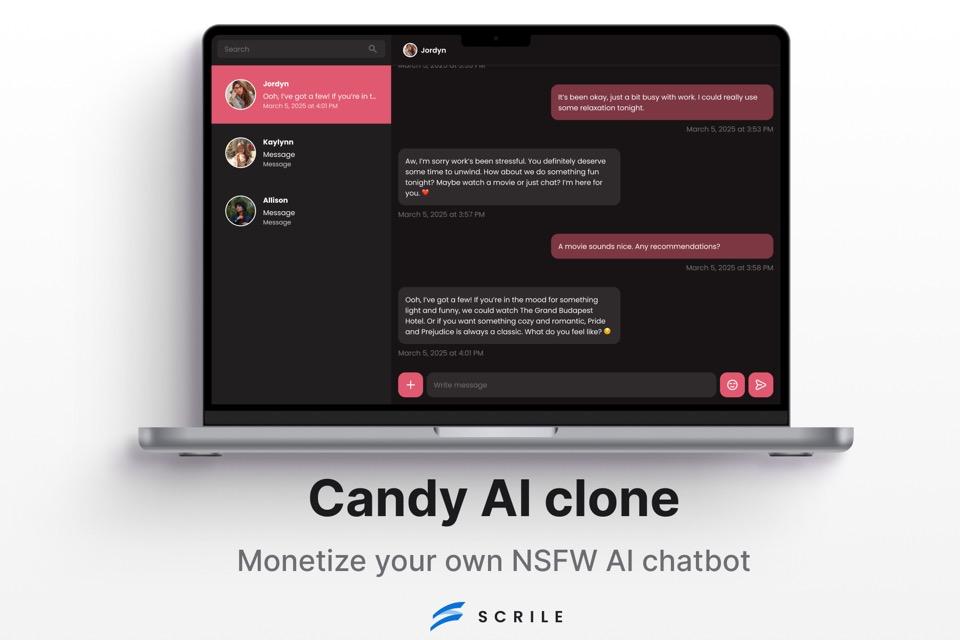
Most businesses start with ready-made APIs for transcription. They’re fast to set up but come with real limits: fixed branding, rising usage costs, and very little control over sensitive data. At some point, scaling organizations realize they need more than just another SaaS subscription.
This is where Scrile AI comes in. It’s not a platform you rent — it’s a development service that builds tailored solutions using speech to text machine learning at the core.
With Scrile AI, companies can shape the product to match their own needs:
- Fully branded UI/UX that looks like part of your ecosystem.
- Flexible deployment — on your own servers or in the cloud.
- Integration with apps you already use, from CRMs to live streaming platforms.
- Multilingual and even NSFW-ready options for industries with special requirements.
The difference becomes clear in real use cases. An edtech company can roll out a private lecture transcription tool, keeping all recordings and notes under its own security policies. A podcast network can embed auto-captioning inside its branded app without relying on an external provider.
Choosing this route means owning the technology, not just paying per request. For businesses thinking long-term, Scrile AI offers a scalable alternative that adapts as they grow, while keeping control of both data and costs.
Conclusion
Python speech-to-text in 2026 has grown into a core technology for businesses that want efficiency and accessibility. Open-source libraries and APIs show what’s possible, but they rarely give companies full control over data, branding, or future scaling. That’s where a tailored path makes sense — and exploring Scrile AI’s custom solutions can be the next step. By reaching out to the Scrile team, businesses can shape speech recognition systems around their exact needs, rather than adapting to someone else’s limits.
Polina Yan is a Technical Writer and Product Marketing Manager, specializing in helping creators launch personalized content monetization platforms. With over five years of experience writing and promoting content, Polina covers topics such as content monetization, social media strategies, digital marketing, and online business in adult industry. Her work empowers online entrepreneurs and creators to navigate the digital world with confidence and achieve their goals.

by Polina Yan
The landscape of Chatfuel competitors is expanding fast as brands seek automated conversations without losing control of tone, data, or workflows. When businesses ask what is Chatfuel, they generally mean a Messenger- and Instagram-first bot platform that lets non-developers build branching flows, keyword triggers, and broadcast sequences. Chatfuel handled early growth in chatbot adoption, but many teams now look toward alternatives that offer more flexibility, richer integrations or better ownership.
That shift matters because the global chatbot market is on a steep upward curve—valued at US $7.76 billion in 2024 and projected to reach around US $27.29 billion by 2030, growing at a 23.3 % CAGR through 2026-30.
In this article, we’ll walk you through five leading Chatfuel competitors, compare their features and pricing side-by-side, and then explain when and why a custom development path makes strategic sense.
Chatfuel in Context
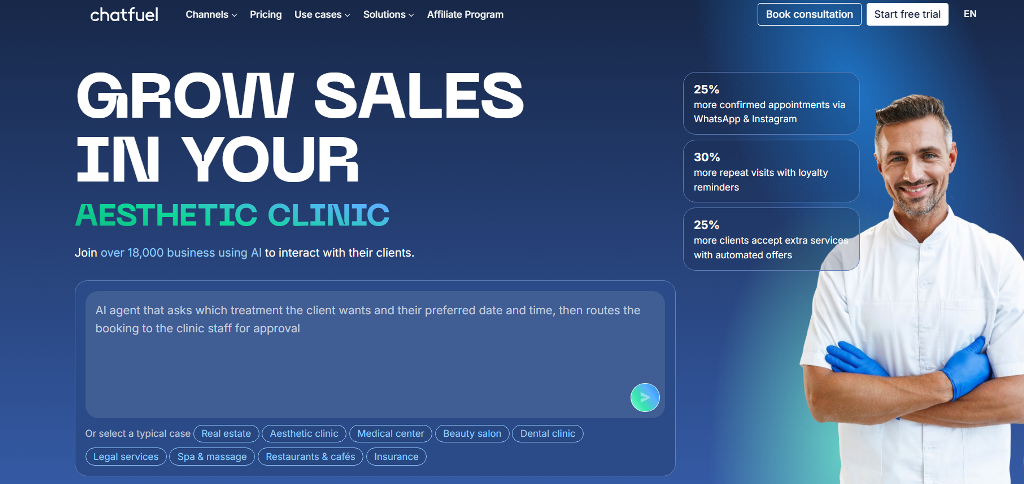
Chatfuel grew popular by giving small teams a quick way to design chat flows without touching code. The platform focuses on channels where automated messages matter most—Facebook Messenger, Instagram DM, and, more recently, WhatsApp. Its builder uses blocks, buttons, keyword triggers, and simple logic steps to shape conversations. There’s also AI autofill for short replies and a set of broadcast tools for announcements or promotional pushes. For many early adopters, it functioned as a chafuel chatbot starter kit: fast to launch, easy to maintain, affordable to scale in the beginning.
Pricing stays within a predictable range. Plans typically start around $24 a month for small audiences and grow toward the $400 mark once brands need higher user limits, more channels, or priority features. The platform works well for straightforward automation, and you’ll find plenty of Chatfuel examples across retail, fitness, and small service businesses—FAQ bots that reduce support tickets, lead-capture flows that qualify customers, and simple routing setups that hand off to human agents.
Still, teams run into constraints once the use case becomes more than a linear script. Some limitations show up early:
- restrictions on branding the interface or embedding the bot into custom environments
- rigid workflows that don’t adapt well to unusual sales funnels or niche product logic
- limited control over data storage and how user information is handled
- dependency on Meta’s rules, which can change the behavior of the bot overnight
These friction points explain why businesses often explore Chatfuel competitors before making a long-term commitment. The moment a company needs deeper integrations, multi-language logic, or ownership of its data, the search for alternatives begins.
Chatfuel Competitors
Chatfuel works well for simple flows, but teams often reach a point where they need more channels, deeper logic, or stronger AI. That’s where the leading Chatfuel competitors start to make sense. Below are five options that show how different builders approach automation—each with its own pricing, strengths, and trade-offs.
ManyChat
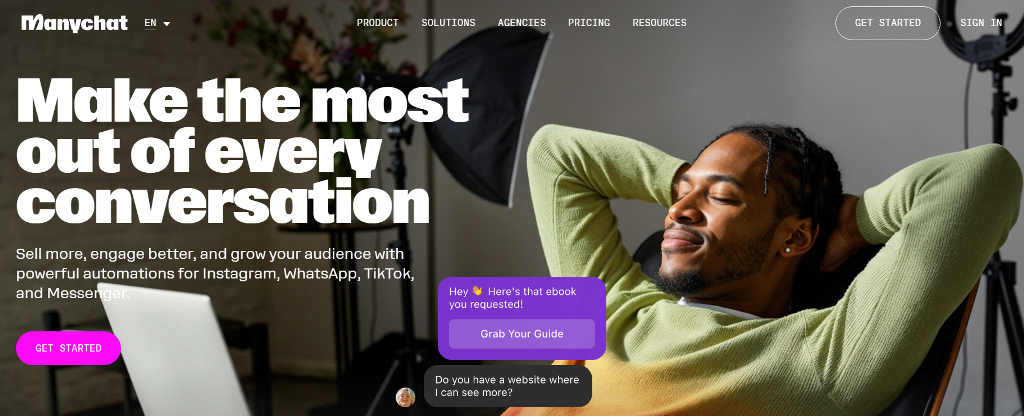
ManyChat is usually the first name people meet when comparing Chatfuel competitors, mostly because it focuses heavily on growth tools for Instagram and Facebook. The interface leans toward creators and small shops that want automation without drowning in technical steps.
Features and channels
ManyChat supports Instagram DM, Facebook Messenger, WhatsApp, and web chat widgets. It offers a visual flow builder, comment auto-replies, story-triggered workflows, basic AI replies, and tools that turn post engagement into leads. The platform also integrates with Shopify, HubSpot, and Google Sheets, which helps teams sync marketing actions with store activity.
Pricing
ManyChat’s free plan covers basic IG + Messenger tools. Paid plans start around $15/month, but costs rise with WhatsApp usage and higher contact volumes, usually landing between $25–$65/month for active small businesses.
Pros
- growth-friendly automations tied to Instagram posts and comments
- simple visual editor suited for non-technical marketers
- good templates for lead capture and appointment flows
- reliable integrations for e-commerce syncs
Cons
- WhatsApp pricing is tied to Meta’s message fees
- limited control over data portability
- branding depends on platform rules
- more lightweight AI compared to newer builders
ManyChat feels more marketing-driven, while Chatfuel leans on structured logic blocks. For teams wanting IG-centric workflows, ManyChat often solves gaps Chatfuel can’t cover.
Botsonic

Botsonic sits on the AI-first side of Chatfuel competitors, designed for teams that want GPT-powered conversations trained on their own data. It feels less like a classic rule-based builder and more like a lightweight LLM interface that you can deploy without engineering work.
Features and channels
The core feature is data ingestion: you upload PDFs, URLs, or text, and Botsonic trains an internal knowledge layer that shapes replies. It connects to websites through an embeddable widget and supports API access for custom deployments. It’s strong for FAQ bots, support assistants, and any use case where answers must reflect documentation rather than canned flows.
Pricing
Paid plans usually start around $16–$41/month, depending on message volume, data limits, and branding controls.
Pros
- quick setup for AI-driven assistants without writing flows
- supports custom knowledge bases with decent accuracy
- widget branding options for website integration
- strong retrieval quality for documentation-heavy businesses
Cons
- conversation style depends heavily on GPT behavior
- fewer multi-channel options compared to other builders
- not ideal for complex funnels that require branching logic
- costs increase when traffic grows
While Chatfuel relies on structured blocks, Botsonic offers flexible AI responses. It attracts teams who prefer natural-language agents over rigid menu flows.
Tidio
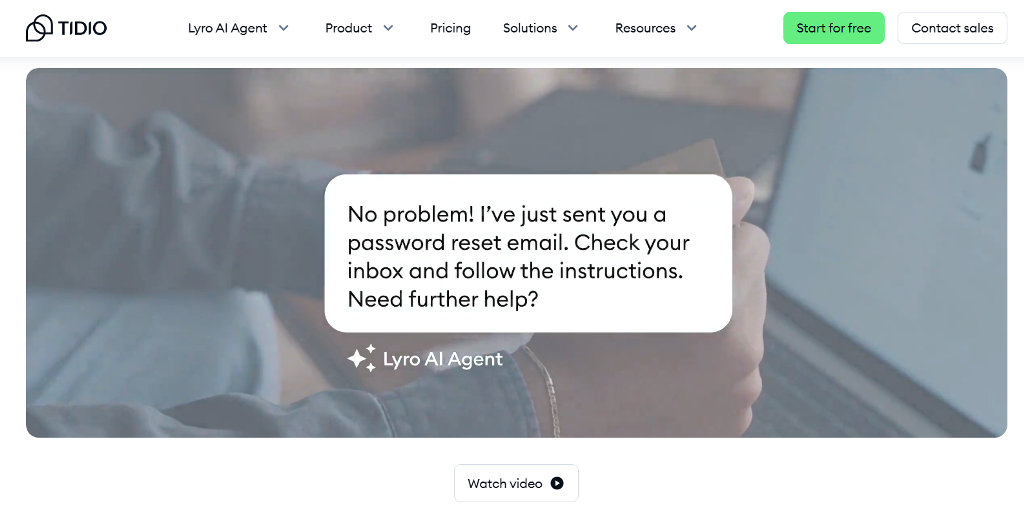
Tidio sits somewhere between live chat, automation, and AI support. Among Chatfuel competitors, it’s one of the strongest for customer service because it blends human agents and bots inside the same panel.
Features and channels
Tidio supports website chat widgets, Instagram, Messenger, email routing, and a growing set of AI features. Lyro—their AI assistant—trains on your help center content and reduces repetitive workload for support teams. The system also includes ticketing, operator dashboards, and simple marketing automations.
Pricing
Paid plans usually start at $24/month for basic automation, while Lyro AI add-ons push total costs into the $49–$749+ range, depending on usage.
Pros
- strong combination of live chat + automation
- Lyro AI reduces support workload for common questions
- ticketing tools included, good for small support teams
- clean, modern interface
Cons
- advanced AI features cost extra
- limited flexibility for multi-step marketing funnels
- branding control depends on plan
- WhatsApp support is still developing
Tidio is better suited for support-heavy teams, while Chatfuel focuses more on predefined sequences. For businesses with active operator teams, Tidio frequently wins.
Landbot
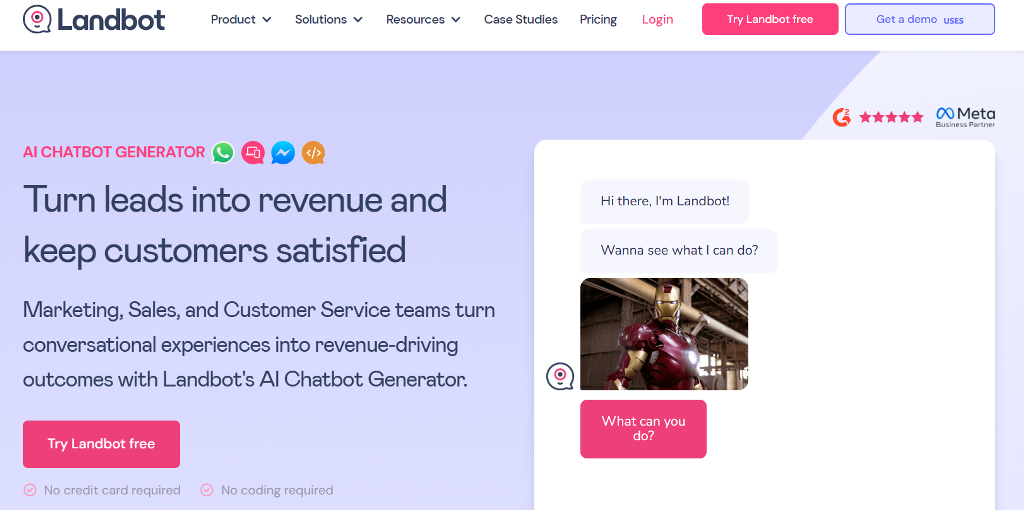
Landbot stands out among Chatfuel competitors because of its visual builder. Everything is laid out as draggable blocks that resemble a mind-map, which makes complex flows easier to reason about. It’s a favorite for teams that want custom logic without writing code.
Features and channels
Landbot supports web chat widgets, WhatsApp, Messenger, and API-based deployments. Its strength is the combination of conditional logic, variables, and integrations with tools like Zapier, Make, HubSpot, and CRMs. It also includes AI modules for semantic intent detection and knowledge-trained responses, but its biggest selling point remains the flexibility of the builder.
Pricing
Landbot starts around $40/month, with WhatsApp consumption fees added on top. More advanced plans for teams and enterprises run into the $200–$400+ range depending on usage and automation volume.
Pros
- one of the best visual flow builders in this category
- strong logic and variable handling for custom experiences
- multi-channel support with reliable WhatsApp integrations
- good fit for companies that need granular funnel control
Cons
- pricing climbs fast for WhatsApp-heavy operations
- AI features are improving but still secondary
- setup takes longer than simpler lightweight tools
- branding options limited on lower tiers
Landbot appeals to teams who need deeper logic than Chatfuel allows—especially when flows go beyond simple branching trees.
Customers.ai (MobileMonkey)
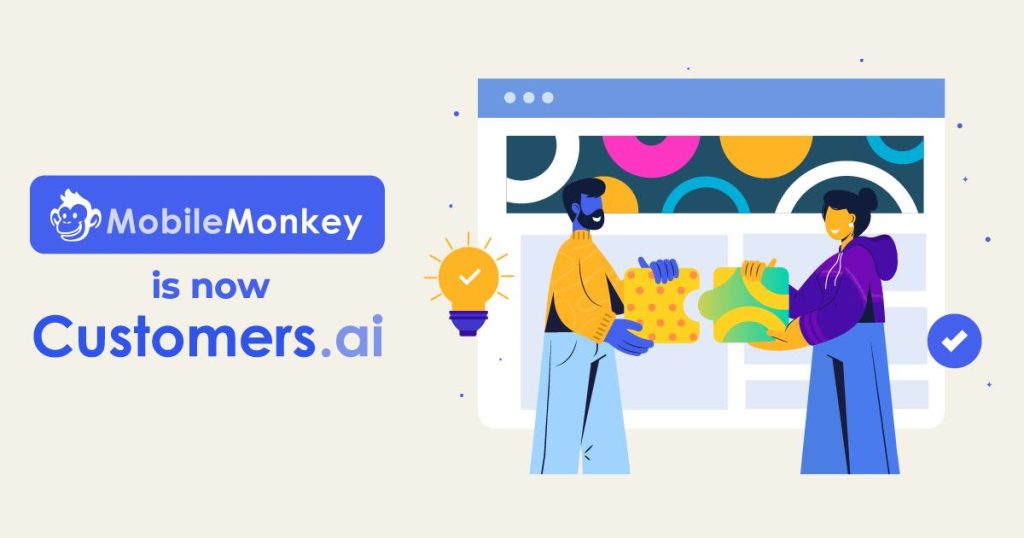
Customers.ai positions itself as a multichannel messaging hub, making it one of the more marketing-focused Chatfuel competitors. It’s built for businesses that want to automate conversations across Instagram, Messenger, SMS, and web chat while keeping all interactions in one inbox.
Features and channels
It includes lead capture tools, drip sequences, omnichannel chat, unified inbox, growth widgets, and automation templates. Customers.ai also offers agency-focused features like client workspaces, white-labeled reports, and team management. AI add-ons include GPT-powered message generation and auto-responses for DM engagement.
Pricing
Customers.ai’s pricing isn’t as transparent as others. Plans typically start at $19–$49/month, but Instagram- and SMS-heavy teams often pay more due to volume-based messaging costs.
Pros
- omnichannel messaging hub with unified inbox
- strong set of tools for agencies and marketers
- Instagram DM automation is reliable
- white-labeling available on higher plans
Cons
- pricing varies depending on channel usage
- fewer native integrations compared to other platforms
- interface can feel cluttered for small teams
- SMS workflows can become expensive
Customers.ai covers more channels than Chatfuel and is better suited for digital agencies or growth marketers managing multiple brands.
Comparison Table
| Feature / Tool | Chatfuel | ManyChat | Botsonic | Tidio | Landbot | Customers.ai |
| Channels | Facebook, Instagram, WhatsApp | Facebook, Instagram, WhatsApp, Web widget | Website widget, API | Website widget, Instagram, Messenger, Email | Website widget, WhatsApp, Messenger, API | Facebook, Instagram, SMS, Web widget |
| AI tools | Basic AI replies, NLP add-ons | Basic AI replies, GPT-style add-ons | GPT-based AI trained on your data | Lyro AI assistant trained on help content | NLP intents, AI modules for semantic routing | GPT-based DM replies, AI prompts for messaging |
| Customization depth | Medium: block-based flows | Medium: visual flows with growth tools | Medium–High: AI behavior plus prompt settings | Medium: flows plus support automation | High: granular visual builder with logic & vars | Medium: omnichannel flows and targeting |
| Branding | Limited to widget + channel styling | Limited on lower tiers, better on higher | Good widget branding, limited host control | Widget styling, basic white-label options | Strong control over widget and experience | White-label and agency branding on higher plans |
| Starting price | ~$24/month | Free tier, paid from ~$15/month | Paid from ~$16–$41/month | Paid from~$24/month | Free tier, paid from ~$39/month | Paid from ~$19–$49/month |
When a Custom Build Outgrows Templates and How Scrile Connect Fills the Gap
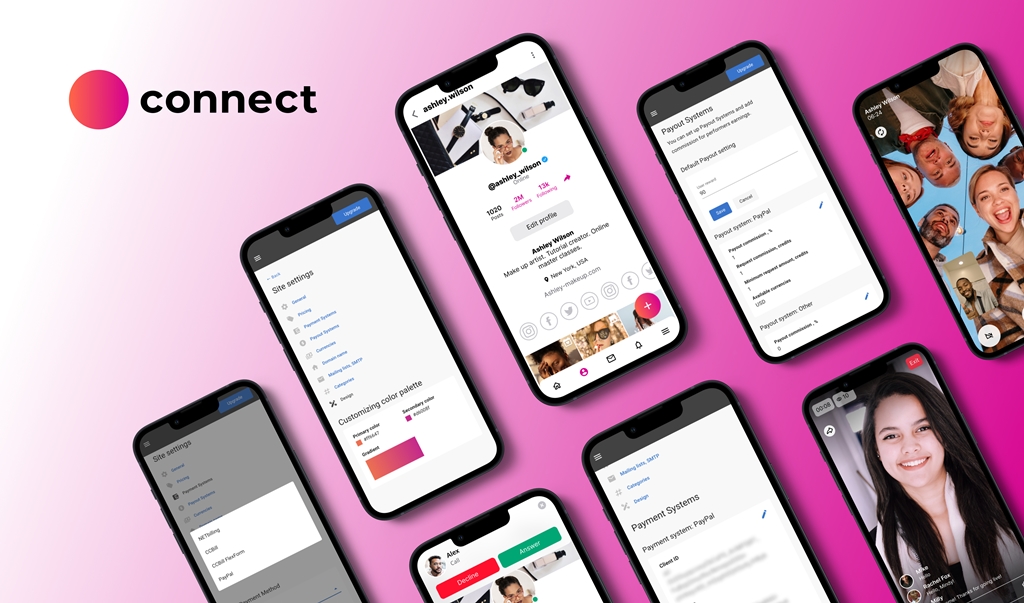
Teams often start with simple chatbot builders, then run into limits the moment their workflows become more specific. Even the strongest Chatfuel competitors cannot support deep branding, custom business logic, or the kind of monetization many platforms rely on. This is usually the point when companies shift from subscription tools to a custom build, and Scrile Connect fits that need because it is not a SaaS product. It is a development service that creates fully owned, private, white-label systems.
Scrile Connect gives companies full control over how their chatbot platform looks, behaves, and integrates. The product is shaped around the client’s business rather than forcing a business to adapt to templates. This includes branded interfaces, unique onboarding flows, payments, gated content, and real-time communication tools that Chatfuel-style builders never support out of the box.
These are the areas where custom development through Scrile Connect becomes practical:
- 100% white-label visual setup with the client’s logo, domain, and design, including custom UI for chat, onboarding, and access levels
- Built-in monetization features, such as subscriptions, tipping, pay-per-view, private video calls, live streams, and content bundles for businesses that need revenue, not just automation
- Flexible payment processing through Stripe, PayPal, CCBill, crypto gateways, PayId19, or custom providers required in specific countries
- Secure data handling with GDPR-ready hosting, moderation tools, and optional age-verification flows for regulated industries
- An admin dashboard for managing users, payouts, analytics, and earnings
- Custom integrations and extended rules, including API-based workflows, CRM syncs, internal systems, and specialized logic that templates cannot support
Scrile Connect has built entire platforms based on these components: multilingual CRM bots, support desks with payments, marketplace onboarding systems, community chat platforms with monetization, and full “Chatfuel-style” builders branded entirely for the client. It becomes a long-term solution that goes beyond what most Chatfuel competitors can deliver.
Conclusion
Comparing different chatbot builders helps teams understand where the limits of template-based systems begin. Many tools handle simple flows well, but businesses eventually need deeper logic, stronger branding control, and ownership of their data. That is where a custom solution becomes more strategic than sticking to presets. Founders who want a scalable, fully branded chatbot experience can work with Scrile Connect to build something shaped around their product rather than a generic framework. Get in touch with the Scrile Connect team to explore your custom build.
Polina Yan is a Technical Writer and Product Marketing Manager, specializing in helping creators launch personalized content monetization platforms. With over five years of experience writing and promoting content, Polina covers topics such as content monetization, social media strategies, digital marketing, and online business in adult industry. Her work empowers online entrepreneurs and creators to navigate the digital world with confidence and achieve their goals.

by Polina Yan
Voice recognition is no longer a future technology but now a mainstream tool in everything from healthcare and customer service to smart assistants and accessibility and automation systems. It is becoming part of everything from apps and messaging to virtual personal assistants and smart devices in the home.
One of the prime movers towards accomplishing this revolution is the swift evolution in artificial intelligence (AI) and natural language processing (NLP). Speech recognition Python-based solutions fueled by AI have evolved immensely in precision to enable real-time transcriptions, voice command recognition, and multilingual recognition.These technologies are making interactions faster and more efficient, whether it’s for virtual assistants like Siri and Alexa, medical transcription services, or automated customer support systems.
Why Python Speech Recognition?
Among the many programming languages used for voice recognition, Python speech recognition stands out as the top choice for developers. Python’s ecosystem offers several powerful libraries that allow developers to integrate speech-to-text functionalities into applications with minimal effort. Its extensive open-source community and machine learning frameworks make it the go-to language for AI-driven projects.
Here’s why Python is widely used for speech recognition:
- Rich library support – Python offers multiple dedicated speech recognition libraries, such as SpeechRecognition, DeepSpeech, and Vosk, that simplify the integration process.
- Ease and usability – Its programming syntax readability allows one to develop complex voice-based AI systems with much ease and flexibility in use
- Robust machine learning and AI features – Python has direct integration with machine learning and deep learning platforms like TensorFlow and PyTorch to enable organizations to construct highly precise, custom-built speech recognition models.
- Cross-platform compatibility – Such systems work across multiple operating systems, ensuring scalability for web, mobile, and embedded applications.
How Speech Recognition Works in Python

Speech recognition enables machines to understand and process spoken language, converting it into readable text or commands. The tech can also provide voice assistants, in-home devices, automated transcription tools, and voice-free systems. Such systems can be developed in a less complicated way through developments in Python speech recognition and with the aid of sophisticated AI-based tools.
Human speech recognition includes both linguistic processing and machine learning models being used correctly in a very complicated process.
At its core, speech recognition isn’t magic — it’s about turning complex sound patterns into understandable language using advanced models. Modern systems often rely on neural networks and deep learning to improve accuracy far beyond simple dictionary matching.
“Whisper is a machine learning model for speech recognition… capable of transcribing speech in English and several other languages, and… improved recognition of accents, background noise and jargon compared to previous approaches.”
— OpenAI on Whisper (speech recognition system), Wikipedia
That’s why libraries like Whisper, DeepSpeech, and Vosk form the backbone of Python speech projects — they leverage modern machine learning architectures to decode human speech in ways older systems could not.
Key Components of Speech Recognition Python Applications
- Acoustic Modeling. Speech consists of phonemes, which are the fundamental units of sound. The AI systems identify these sounds and match them to their corresponding letters or syllables. Acoustic models enable the recognition of words that sound alike and handle the variations in pronunciation.
- Language modeling. The system then has to organize words and sentences in a coherent order after sensing phonemes. Prediction models enhance recognition by predicting words that most likely follow in a sentence in largely the same manner that autocorrect or predictive input works in cell phones.
- Noise Filtering & Audio Processing. Recognition of speech is not only about recognizing words—participating words must be filtered from ambient noise and sound. Most speech recognition Python libraries come with noise cancellation to enhance the performance in real scenarios, i.e., in the office, in a crowd, or in the context of in-car free hand conditions.
Neural Network Processing. They have the latest speech recognition systems using AI and deep models to improve accuracy levels. Advanced deep models and AI assist the systems in identifying patterns in enormous amounts of spoken data to adapt to accents and dialects and patterns changing with time.
Top Python Speech Recognition Libraries in 2026
Python offers a variety of powerful speech recognition libraries, each suited for different use cases. Whether you need a lightweight API-based tool, an offline speech recognition system, or an advanced deep learning model, there’s a solution available. Below is a comparison of the five best speech recognition Python tools in 2026, covering their strengths, weaknesses, and ideal use cases.
Comparison of Top Python Speech Recognition Libraries
| Library | Type | Strengths | Weaknesses | Best For |
|---|
| SpeechRecognition | Wrapper for multiple APIs | Easy to use, lightweight, flexible, supports Google/IBM/Microsoft | Internet dependent, weak offline support | Quick integration, basic transcription |
| Mozilla DeepSpeech | Offline, open-source, TensorFlow-based | High accuracy, customizable, privacy-friendly | Needs GPU/high CPU, large models | Privacy-sensitive apps, custom AI |
| Vosk | Offline, lightweight | Low latency, multilingual, works on embedded devices | Limited pre-trained models, requires tuning | IoT, Raspberry Pi, smart devices |
| Google Speech-to-Text API | Cloud-based | Very accurate, real-time streaming, auto-punctuation | Subscription costs, needs internet, latency risk | Enterprises, live transcription, call centers |
| OpenAI Whisper | AI-powered, multilingual | Extremely high accuracy, understands accents & noise, context-aware | Heavy resource use, slower on low hardware | Journalism, podcasts, multilingual assistants |
SpeechRecognition

SpeechRecognition is one of the most widely used Python libraries for speech-to-text conversion. It acts as a wrapper for multiple speech recognition engines, making it easy to integrate with cloud-based and offline services. The library supports APIs like Google Web Speech, CMU Sphinx, IBM Speech to Text, Wit.ai, and Microsoft Azure Speech.
Strengths:
- Easy to implement – Requires minimal setup and works with a simple API call.
- Lightweight – Does not require extensive computational power.
- Flexible – Supports multiple speech engines, allowing developers to choose the best fit.
Weaknesses:
- Internet dependency – Most of its features rely on cloud APIs, requiring an internet connection.
- Limited offline capabilities – The CMU Sphinx engine is available for offline use but lacks accuracy compared to deep learning-based alternatives.
Best Use Cases:
- Quick speech recognition integration into Python applications.
- Developers looking for a simple API to access Google or IBM speech services.
- Basic transcription needs where internet access is available.
Mozilla DeepSpeech
Mozilla DeepSpeech is a deep learning-based, open-source speech recognition system built on TensorFlow. It is trained on thousands of hours of voice data and offers high accuracy, even in challenging conditions. Unlike cloud-based solutions, DeepSpeech runs entirely offline, making it suitable for privacy-sensitive applications.
Strengths:
- Fully offline processing – No internet connection required.
- High accuracy with proper training – Can be fine-tuned with custom voice data.
- Open-source flexibility – Developers can modify and improve models based on their needs.
Weaknesses:
- Requires high computational power – Best suited for systems with GPUs or high-end CPUs.
- Large model size – Can be resource-intensive compared to lightweight libraries like SpeechRecognition.
Best Use Cases:
- Privacy-focused applications that require offline speech recognition.
- AI-driven applications needing accurate speech-to-text conversion.
- Developers looking to fine-tune a speech model for a specific use case.
Vosk
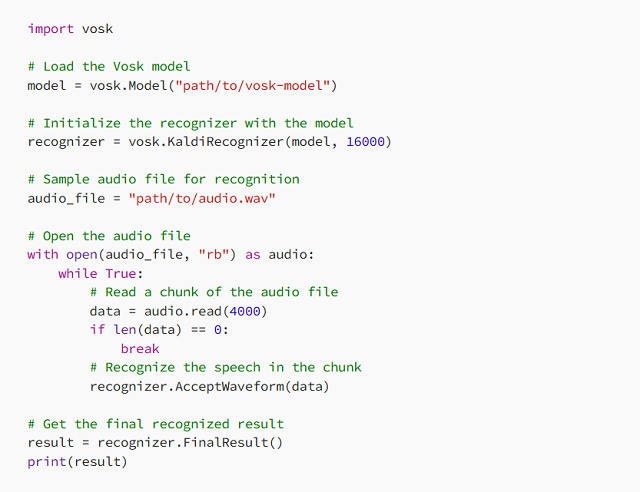
Vosk is a lightweight, offline speech recognition Python library designed for low-power devices like Raspberry Pi and embedded systems. It supports multiple languages and provides real-time speech processing with minimal resource consumption.
Strengths:
- No internet dependency – Works completely offline.
- Low latency – Optimized for real-time applications.
- Multilingual support – Recognizes speech in over 20 languages.
Weaknesses:
- Fewer pre-trained models compared to cloud-based APIs.
- Requires additional tuning to improve accuracy for niche applications.
Best Use Cases:
- Embedded systems (Raspberry Pi, IoT applications, smart home devices).
- Developers needing offline speech recognition with minimal hardware requirements.
- Multilingual speech processing for global applications.
Google Speech-to-Text API
Google Speech-to-Text API is a cloud-based speech recognition service that provides highly accurate transcription using Google’s deep learning models. It supports real-time and batch processing, making it suitable for applications requiring fast and scalable speech recognition.
Strengths:
- High accuracy across multiple languages.
- Supports real-time streaming for live applications.
- Includes auto-punctuation and noise cancellation features.
Weaknesses:
- Requires a Google Cloud subscription, which can be expensive for high-volume applications.
- Latency issues may arise in environments with poor internet connectivity.
Best Use Cases:
- Large-scale enterprise applications needing cloud-based transcription.
- Call centers and customer support automation.
- Live streaming applications requiring real-time speech-to-text conversion.
OpenAI Whisper
OpenAI Whisper is an AI-powered speech recognition Python model trained on a massive dataset of multilingual speech. It is designed for high-accuracy transcription, multi-language support, and natural conversation understanding.
Strengths:
- Extremely high accuracy, even with accents and noisy backgrounds.
- Supports multiple languages, making it ideal for global applications.
- AI-driven transcription with improved contextual understanding.
Weaknesses:
- Requires significant processing power for real-time applications.
- Can be resource-intensive compared to lightweight libraries.
Best Use Cases:
- High-accuracy transcription services for podcasts, interviews, and journalism.
- AI-driven voice assistants with multilingual capabilities.
- Businesses needing contextual understanding beyond simple speech-to-text conversion.
Python continues to be a leading choice for developing speech recognition applications due to its extensive library support. Whether you need a simple API-based tool like SpeechRecognition, an offline solution like Vosk, or an advanced AI-powered model like OpenAI Whisper, there is a Python speech recognition library suited for your project.
Choosing between open‑source libraries and cloud‑based speech APIs isn’t just a technical decision — it’s a strategic one. The tradeoffs often come down to control versus convenience.
“Open-source solutions… offer the flexibility to modify the code to meet specific requirements. However, open-source solutions… must be provided and managed by you… Additionally, the accuracy of open-source tools is often inferior to that of cloud-based alternatives…”
— AssemblyAI, “Python Speech Recognition in 2025”
This highlights why many developers start with an API like Google Speech or AssemblyAI for accuracy and then graduate to local, customized systems when they need more control, privacy, or offline capability.
How to Implement Python Speech Recognition in Your Project

Python speech recognition systems have made changing the way that companies automate processes, communicate with users, and process voice data a reality. From virtual assistant-based systems powered by artificial intelligence to voice command and real-time transcription and voice-controlled smart devices, application utilization of speech recognition must be weighed and optimized.
To successfully implement Python speech recognition technology, firms have to select the right library, calibrate processing to realworld specifications and integrate the tool into the process. High accuracy cloud-based APIs are required in some applications while independent and offline models work in others
The secret to an effective speech recognition Python project is finding the ideal balance between accuracy and speed and being in a position to connect well with other systems.
Setting Up a Python Speech Recognition System
Before diving into implementation, it’s important to define what the speech recognition system will be used for. A real-time transcription service requires high-speed processing, whereas an AI chatbot might need natural language understanding in addition to voice-to-text conversion.
Once the use case is clear, the next step is setting up the development environment. This involves installing the necessary Python libraries and configuring the system for optimal performance.
Cloud-Based vs. Offline Speech Recognition
One of the first decisions businesses face when implementing Python speech recognition is whether to use cloud-based or offline speech processing.
Cloud-based services, such as Google Speech-to-Text or OpenAI Whisper, provide high accuracy and continuous improvements because they leverage deep learning models trained on massive datasets. These services are ideal for applications that require real-time, multilingual speech recognition. However, they depend on an internet connection and often come with ongoing usage costs.
Offline models, like DeepSpeech and Vosk, process voice data directly on the device, making them a great choice for privacy-sensitive applications where data security is a concern. These solutions allow businesses to avoid external API costs, but they may require fine-tuning and additional computational resources for training and optimization.
For businesses operating in high-security industries, such as healthcare, finance, and legal services, offline models provide greater control over voice data without relying on third-party providers.
Optimizing Speech Recognition for Accuracy and Performance
The speech recognition model is as good as the quality input it gets. Even the most advanced AI-based systems fail to handle poor quality audio, high levels of background noise, or heavy accents. To have a better recognition percentage, companies need to work on sound optimization and model adjustment from the AI end
Major factors affecting accuracy in speech recognition:
- Audio Quality – High-quality microphones and noise elimination methods enhance speech audibility and produce better transcription accuracy.
- Background noise management – Using sound filtration and noise cancellation techniques enables speech models to tune in to the voice of the speaker
- Speaker Adaptation – Training models to recognize multiple accents and speaking patterns ensures higher accuracy to multiple clusters of users
- Word Choice Within Domain – Training models to a domain-specific lexicon increases awareness to business-specific usage
For multiple language applications, multiple language support will be required. There exist Python speech recognition libraries that natively support multiple languages and those that allow multiple language support through changing between multiple models trained in different languages. Business organizations that have international scope should prefer solutions with robust language processing
Integrating Speech Recognition into Business Applications
Speech recognition technology is now being widely adopted across various industries, providing businesses with new opportunities for automation and customer interaction. The implementation of this technology depends on the specific use case and industry requirements.
depends on the specific use case and industry requirements.
Real-World Business Applications of Python Speech Recognition:
- AI-powered Customer Service – Virtual and AI-powered chatbots utilize speech recognition to comprehend the inquiries of the customers and respond automatically.
- Medical Transcription Services – Physicians would not be depending on speech-to-text systems to auto-document along with note-taking.
- Financial & Legal Transcription – It reduces paperwork in financial reports and legal cases and client conversations
- Hand-Free devices for Smart devices – Devices with IoT such as voice assistant smart home devices and voice command in vehicles use voice recognition to offer hand-free services.
- Live Captioning & Subtitling – Automatic transcription tool helps organizations produce live captions in real-time online conferences, webinars, and live streams.
Each of these use cases requires different levels of accuracy, latency, and language processing capabilities, making it essential to choose the right speech recognition Python solution for the job.
Ensuring Scalability and Security in Speech Recognition Applications
Scalability is a paramount concern for businesses handling vast volumes of voice data. A speech recognition system must be capable of handling thousands of interactions simultaneously without compromising speed or accuracy.
Security is also an important concern, particularly when dealing with sensitive user data. Some industries, such as finance, healthcare, and government, must comply with strict data privacy regulations like GDPR and CCPA.
To ensure compliance, businesses should consider:
- On-premises speech recognition solutions for greater control over data.
- End-to-end encryption for protecting voice interactions.
- AI bias mitigation to prevent inaccuracies based on speaker demographics.
Balancing performance, security, and cost-efficiency is essential for businesses that rely on AI-powered speech recognition for mission-critical applications.
Challenges and Limitations of Speech Recognition
While Python speech recognition has advanced significantly, real-world implementation comes with several challenges that affect accuracy, speed, and user experience. Companies implementing speech-to-text solutions need to overcome technical constraints to support fluent and seamless functioning.
Background noise is one of the biggest issues. In noisy environments like offices, public spaces, and call centers, speech recognition models struggle to distinguish the speaker’s voice from background noises, simultaneous conversations, or echoing acoustics.This leads to continuous misinterpretations, which makes the system less reliable.
Another challenge is dialect and accent recognition. While many speech recognition Python models are trained on standardized datasets, they often fail to accurately process regional accents, fast speech, or non-native pronunciations. This can result in incorrect transcriptions or repeated errors, making the system frustrating for diverse user groups.
Latency is another concern, particularly for real-time speech recognition applications. Systems requiring real-time voice-to-text transformation, such as AI chatbots or live transcription software, need to maintain processing latency as low as possible. High latency can make interactions respond slowly or become unresponsive, affecting user experience in a negative manner.
To overcome these limitations, businesses optimize their speech recognition models using noise reduction filters, AI-powered learning, and continuous model fine-tuning. By adapting speech recognition Python solutions to real-world conditions, companies can significantly improve accuracy and performance.
Scrile AI: The Best Custom Development Service for Python Speech Recognition
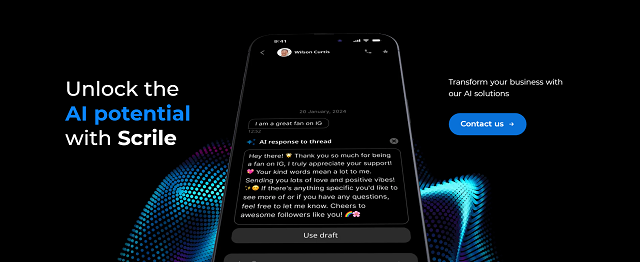
Businesses looking to implement speech recognition Python solutions need more than just an off-the-shelf API—they need a customized, scalable, and efficient system that seamlessly integrates with their existing workflows. Scrile AI offers a tailored approach to speech recognition development, ensuring that businesses get precisely the features, accuracy, and performance they need.
Contrary to typical cloud-based applications limiting personalization and control, Scrile AI provides fully customized speech recognition models, designed for industry-specific use. Customer service automation, medical transcription, legal documentation, or voice-based smart apps, Scrile AI provides cutting-edge AI solutions on the basis of proprietary business requirements.
Why Choose Scrile AI Over Off-the-Shelf Solutions
| Option | Ownership | Customization | Security | Scalability | Integration | Weak Points |
|---|
| Off-the-Shelf APIs (Google, IBM, etc.) | Belongs to provider | Limited, generic models | Provider-dependent compliance | Scales with cost | Easy to plug & play | Vendor lock-in, recurring fees |
| Open-Source Models (Vosk, DeepSpeech, Whisper) | Open community | High, but requires expertise | Depends on implementation | Flexible, but resource heavy | Needs dev effort | Requires AI/ML specialists |
| Scrile AI (Custom Python Development) | Full client ownership | Tailored to industry (medical, legal, finance, support) | GDPR/CCPA compliant, business-grade | Enterprise-level, low-latency, live-ready | Seamless integration into existing apps | None — handled as turnkey by Scrile |
What Scrile AI Offers
Scrile AI specializes in custom-built AI solutions, allowing businesses to leverage advanced Python speech recognition technology while maintaining complete ownership and flexibility over their systems.
- Custom speech recognition models – Tailored for specific industries to give higher accuracy in specialized vocabulary and use cases.
- Seamless integration – Integrates with existing apps, software environments, and backends without problems of compatibility.
- Scalable infrastructure – Designed to process live voice handling with high-speed transcription and low latency.
- Multilingual speech recognition – Supports multiple languages and dialects, making it ideal for global businesses.
Why Choose Scrile AI Over Off-the-Shelf Solutions?
The majority of companies begin with third-party APIs but later discover that pre-existing solutions are significantly limiting. Scrile AI escapes vendor lock-in and platform limitations and offers:
- End-to-end bespoke AI models – No reliance on third-party, and thus companies will fully own their technology.
- Business-class security – GDPR, CCPA, and other data privacy law compliant, hence secure and safe voice data processing.
- Support and scalability – Engineered for businesses who need long-term stability, upkeep, and nurturing for mass scale operations.
For businesses serious about building powerful, AI-driven voice solutions, Scrile AI provides the best Python speech recognition development service available. Explore Scrile AI’s custom AI solutions today and bring advanced speech recognition capabilities to your business.
Conclusion
The landscape of Python speech recognition is evolving rapidly, with numerous libraries that offer advanced features for real-time transcriptions, AI assistants, and voice automation. The choice of the appropriate tool depends on your needs, levels of accuracy, and scalability objectives.
For businesses that require custom solutions, relying on pre-built APIs may not be enough. Scrile AI provides tailored AI development, ensuring full control, security, and seamless integration into any application.
Take the next step—explore Scrile AI today and build a custom AI-powered speech recognition Python system.
Polina Yan is a Technical Writer and Product Marketing Manager, specializing in helping creators launch personalized content monetization platforms. With over five years of experience writing and promoting content, Polina covers topics such as content monetization, social media strategies, digital marketing, and online business in adult industry. Her work empowers online entrepreneurs and creators to navigate the digital world with confidence and achieve their goals.

by Polina Yan
Scheduling tools run half the modern service economy. Coaches, small clinics, tutors, wellness studios, and consultants rely on booking software to keep their calendars from collapsing. Acuity built a strong early lead, but 2026 looks different. The user base expanded, demands changed, and patience shrank. Across Reddit threads and review platforms, people describe the same friction: slow loading during busy hours, limited customization, and the sense that Acuity works best only if you stay inside the Squarespace ecosystem. That shift is why more teams compare Acuity alternatives before committing to another year.
Some want easier integrations. Others want better branding, smarter automation, or a tool that fits how they actually deliver services. This guide walks through the reasons users move on, the criteria that matter when choosing a replacement, the strongest options available, and what a custom-built solution can offer when ready-made tools can’t keep up.
Why Users Replace Acuity Scheduling

Acuity Scheduling has been around long enough to become the default choice for many small operations. The entry plan usually falls somewhere around $16 per month, with higher tiers reaching roughly $49 as more calendars and features get added. For a solo consultant, that’s manageable. Trouble appears once a business tries to scale or needs a workflow outside Acuity’s narrow lane.
A second piece of context matters here: Acuity became a Squarespace product after the 2019 acquisition. That shift worked well for users already building their websites on Squarespace, but it also created a wave of confusion. Some people search Squarespace Scheduling vs Acuity as if they were unrelated tools. Others ask is Acuity and Squarespace the same thing, trying to understand how tightly the two products overlap. The simplest way to describe it is this: Acuity lives in the Squarespace family, but it still behaves like its own standalone scheduler — with its own advantages and its own ceilings.
Once people look past the branding link, the same pressure points surface again and again:
- Automation runs out of room. Reminders and basic follow-ups exist, but anything beyond simple sequences requires workarounds.
- Branding tools feel thin. Businesses want booking pages that match their identity, not generic forms with basic color swaps.
- Team scheduling becomes pricey. As more calendars get added, the overall subscription jumps fast, pushing people toward tools listed as Acuity Scheduling Competitors.
- Multi-location logic is limited. Clinics, salons, and coaching groups often need resource rules, roles, and complex timetable management. Acuity doesn’t stretch far.
- Squarespace users feel boxed in. Some stay only because it’s bundled. When they try to migrate, the ecosystem makes it harder than expected.
User Pain Points Surfaced Across
The finer details matter even more. Many reviews mention lag during peak usage, confusing time-zone conversions for international clients, and shallow intake form controls. Those issues sound small until they hit real business scenarios.
A yoga studio needs strict class-size limits and waitlists. A consultant juggling different services wants separate intake steps for each. A clinic needs layered permissions so staff only see their own schedules. When these needs collide with Acuity’s ceiling, the workflow breaks. That is the moment people start looking for Acuity alternatives that match the complexity of their daily work instead of forcing them into rigid templates.
How to Evaluate the Right Alternative

Once a team decides to move on, comparing tools becomes overwhelming. Websites pitch similar features, and marketing copy hides the details that matter. These points help filter the noise when reviewing Alternatives to Acuity Scheduling.
Pricing logic defines long-term cost. Some tools charge per staff member. Others price by feature tier. A business with ten calendars will feel a per-seat plan immediately, while a solo operator won’t.
Integration depth shapes workflow. Strong options sync cleanly with Google Calendar, Outlook, Stripe, PayPal, or CRMs. Teams using Zoom or Microsoft Teams need native video integrations, not meeting links pasted manually.
Automation determines how much the tool actually saves time. Good alternatives can handle follow-ups, reminders, cancellations, and sequences that change depending on the service.
Branding and white-labeling influence client perception. Some businesses need a booking page that looks like part of their site—not an embedded widget with limited styling.
Data ownership and export rules matter more than people expect. Vendors that lock down exports create headaches later. Good platforms let teams back up client lists, booking records, and financial reports without obstacles.
Vendor lock-in is a real risk. Some tools work beautifully until a team needs something slightly unusual. If the platform can’t bend, the business ends up switching again.
With these factors in mind, evaluating Acuity alternatives becomes far more honest and less about shiny features.
The Top Acuity Alternatives for 2026
Choosing between the many Acuity Alternatives can feel messy until you compare them in a structured way. Different tools work better for different rhythms: some are built for speed, some for teams, some for people who need fine-tuned branding. Below are five options worth looking at in 2026, each with a clear purpose and transparent pricing so you can decide which one genuinely fits your workflow.
Calendly
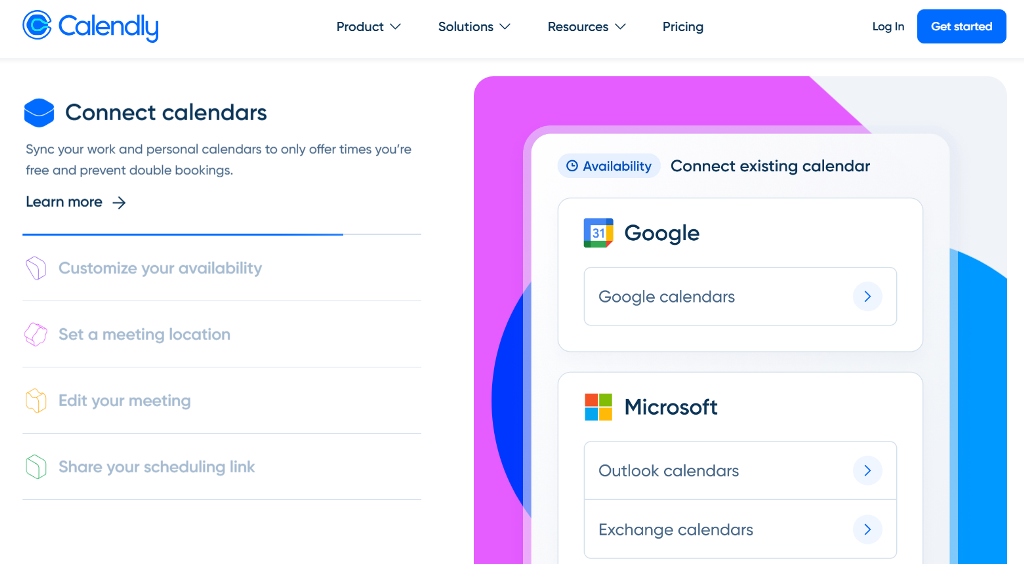
Best for: professionals and teams who want quick scheduling with minimal setup.
Calendly built its reputation on simplicity. You pick your availability, share a link, and clients book without friction. It supports Google and Outlook calendars, plugs into Zoom and Teams, and includes automatic reminders. The tool works especially well for consultants, recruiters, and sales teams that rely on fast back-and-forth scheduling.
Pros:
- Very fast initial setup.
- Large integration library.
- Clean booking pages with predictable behavior.
Cons:
- Branding options feel limited.
- Not ideal for service providers who need intake steps or questionnaires.
Pricing: starts with a free plan; paid seats typically fall into the $10–$16 range.
One of the clearer Acuity scheduling alternative options for straightforward workflows.
Microsoft Bookings
Best for: teams inside Microsoft 365, HR departments, clinics, and corporate training operations.
Bookings works well because it fits naturally into the Microsoft ecosystem. If a team already uses Outlook, Teams, OneDrive, or SharePoint, setup feels almost seamless. Admins can manage staff calendars, service types, and permissions from one interface. Video calls integrate directly into Teams without extra work.
Pros:
- Strong fit for enterprises and corporate teams.
- Deep integration with Outlook and Teams.
- Useful for multi-staff environments that require internal permissions.
Cons:
- Confusing for freelancers or small service providers.
- Customization is limited compared to more flexible tools.
Pricing: included in many Microsoft 365 Business subscriptions; some plans cost $6–$22 per user depending on region and licensing.
Great option for organizations already anchored in Microsoft workflows.
Zoho Bookings
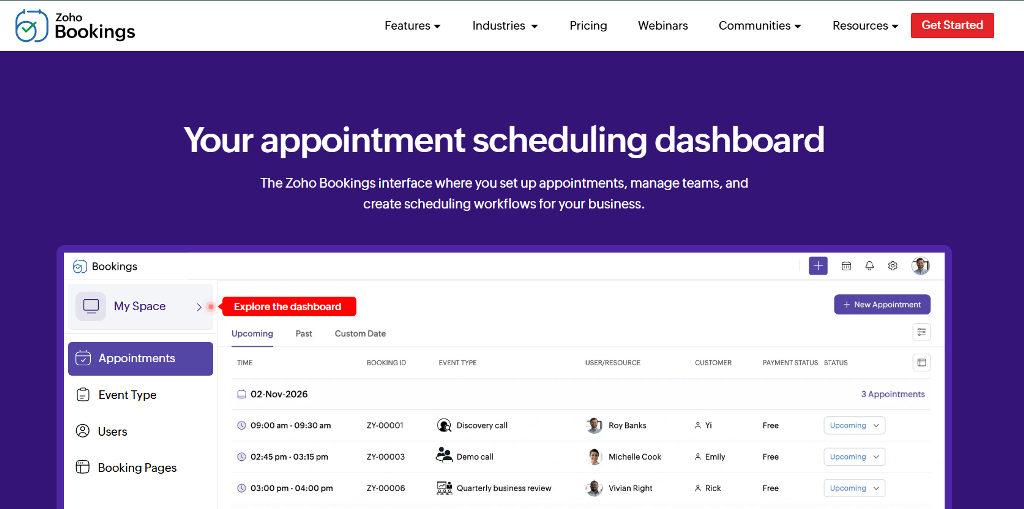
Best for: service teams, coaches, educators, and growing businesses that want automation depth without enterprise pricing.
Zoho Bookings benefits from living inside the broader Zoho suite. Teams can link scheduling with CRM, invoicing, campaigns, and helpdesk tools. Workflows support conditional logic, customized intake, and reminders tied to different service categories.
Pros:
- Automation that adapts to varied appointment types.
- Strong connections to Zoho CRM and external calendars.
- Affordable for multi-staff setups.
Cons:
- UI takes time to master.
- Branding tools are solid but not limitless.
- Sync delays occasionally appear when using many Zoho apps at once.
Pricing: plans range from $6 to $9 per user/month.
Zoho is a strong choice for teams that want deeper workflows without jumping into more expensive enterprise platforms.
Setmore
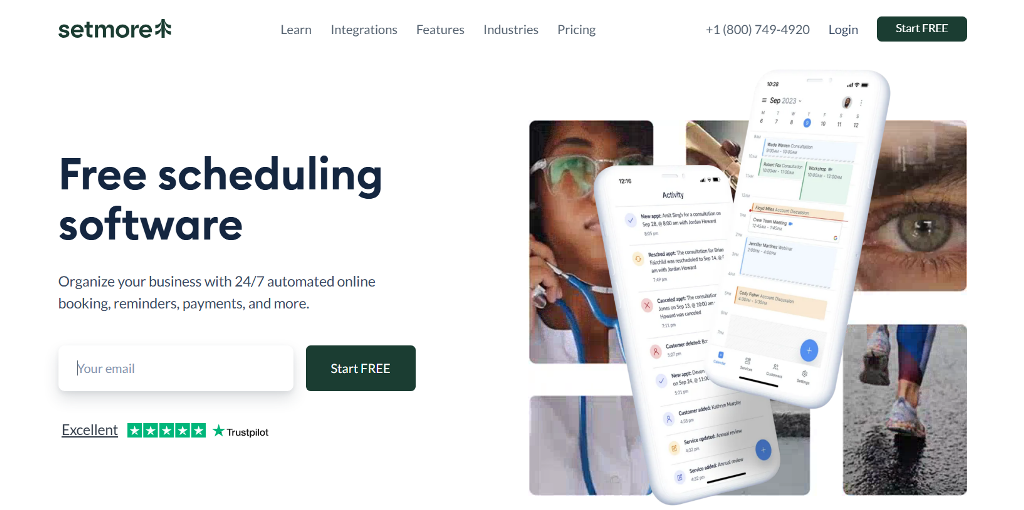
Best for: barbers, fitness coaches, massage therapists, and other small operations that want simple booking with a professional touch.
Setmore is known for its generous free tier and easy learning curve. It connects with Facebook and Instagram, letting clients book directly through social profiles—useful for small businesses that don’t rely on heavy websites. Its appointment pages feel clean and mobile-ready.
Pros:
- One of the best free plans in the category.
- Social media booking tools built in.
- Simple interface that doesn’t overwhelm new users.
Cons:
- Reporting and analytics stay fairly light.
- Limited customization for advanced workflows.
Pricing: free tier available; paid plan lands around $5–$12 per user/month depending on the billing cycle.
Among the most straightforward Acuity alternatives for small, fast-moving service providers.
YouCanBookMe
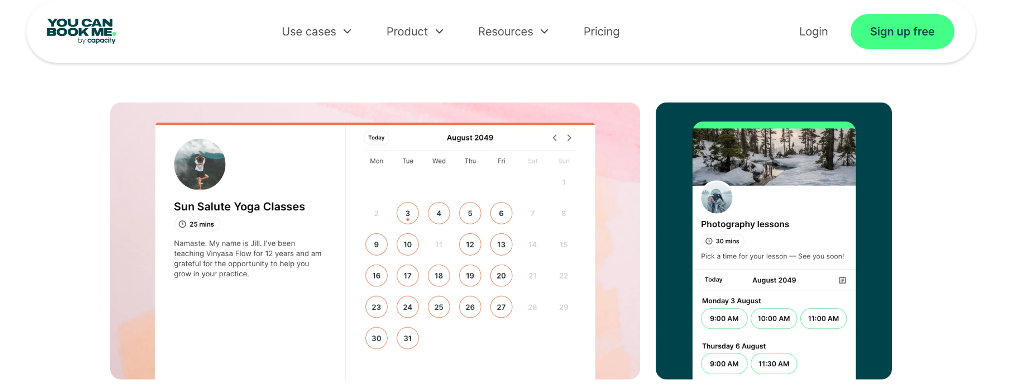
Best for: educators, consultants, freelancers, and teams that want calendar-driven booking with strong personalization.
YouCanBookMe focuses on customization inside a simple framework. Users can adjust text, layout, email templates, and time-slot rules without touching code. It shines in environments where tight syncing with Google or Outlook matters more than complex automation.
Pros:
- Excellent email and template personalization.
- Intuitive time-slot control.
- Reliable calendar syncing.
Cons:
- Not built for complex multi-location scheduling.
- Limited workflow automation.
Pricing: typically $7–$14 per calendar/month, depending on billing cycle; free plan is available.
A strong pick for teams reviewing Acuity Scheduling Alternatives that emphasize communication over heavy operational structure.
Create a Turnkey Online Booking System With Scrile Connect
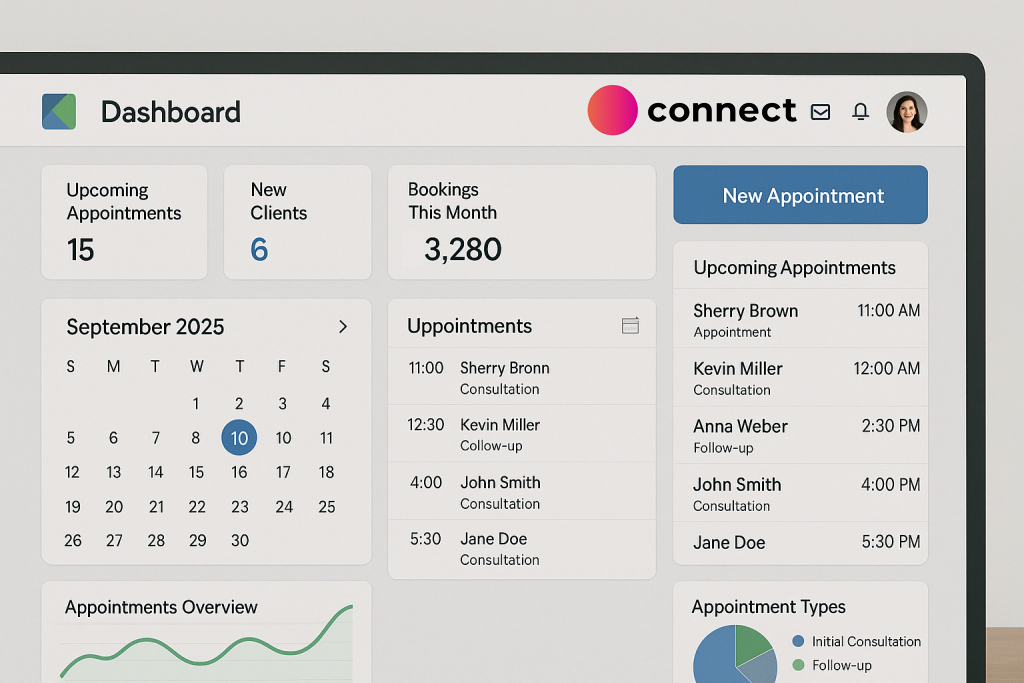
All the tools above solve scheduling in their own way. They work best when a business fits the mold they were built for. But many teams don’t. They run unusual appointment types, manage multiple service layers, or need a branded client experience that prebuilt software can’t offer. That’s where Scrile Connect comes in—not as another booking app, but as a custom-built system shaped around the business itself.
Scrile Connect is a development service, not a SaaS subscription. The team builds a private scheduling platform with the exact features a business needs: unique intake flows, multi-role dashboards, resource-based scheduling, class and group booking logic, membership areas, integrated payments, messaging, or anything else required. Because everything is custom, there are no constraints on layout, branding, automation, or workflows.
Key advantages:
- Custom UI and branding that match the business perfectly.
- Scheduling flows built from scratch for the service type.
- Payment logic, subscriptions, bundles, or credit systems.
- Multi-staff permissions, internal notes, and audit tools.
- API-based structure for future integrations and expansion.
- Full data ownership with no platform lock-in.
For businesses that outgrow Acuity—or any replacement—Scrile Connect offers a way to build an alternative to Acuity Scheduling that truly fits how the team works.
Conclusion
The market for scheduling tools is broader than ever, with Acuity Alternatives available for nearly every business stage and need. From simple booking apps to robust client management systems, the right solution depends on your goals and workflow. When out-of-the-box tools no longer fit, custom development becomes the smartest next step. Scrile Connect offers tailored platforms designed to scale with your business.
Explore what Scrile Connect can build for you — and move beyond limitations.
FAQ
What’s better than Acuity Scheduling?
Different tools excel in different areas. Calendly handles quick booking; Microsoft Bookings works well inside corporate Microsoft 365 setups; Zoho Bookings adds automation and CRM links; YouCanBookMe focuses on personalization; Setmore gives small businesses an easy free option. These are the main competitors among modern Acuity alternatives, and the right choice depends on the workflow.
Is there a free version of Acuity Scheduling?
Acuity doesn’t offer a permanent free plan, but new users get a free trial. It’s enough to test basic booking, reminders, and calendar syncing before committing to a paid tier.
Is Calendly or Acuity better?
Calendly fits teams that want fast, simple scheduling with clean integrations and minimal setup. Acuity suits people who need packages, memberships, or deeper client management.
Polina Yan is a Technical Writer and Product Marketing Manager, specializing in helping creators launch personalized content monetization platforms. With over five years of experience writing and promoting content, Polina covers topics such as content monetization, social media strategies, digital marketing, and online business in adult industry. Her work empowers online entrepreneurs and creators to navigate the digital world with confidence and achieve their goals.

by Polina Yan
If you run anything that schedules people—haircuts, yoga sessions, tutoring slots, therapy calls, repair visits, church meetings, coaching sessions—you already know the calendar rules the day. It decides who shows up, who pays, and how much time is left to actually work. Tools like Setmore make that easier, which is why so many small and mid-sized teams start there. It does the basics well: online booking pages, reminders, payments, and staff calendars. But as businesses grow, they start hunting for Setmore alternatives because operations don’t all follow the same script.
Some teams need intake forms and recurring sessions. Others want group bookings, custom branding, deposits up front, marketplace-style scheduling, or deeper integration with internal dashboards. That’s where the differences really show.
This article looks at what Setmore does right, where it falls short, and how other scheduling tools compare on features, pricing, and control. We’ll walk through several competitors that fit different use cases, then look at what happens when switching tools still doesn’t solve the deeper workflow issues—and why some teams eventually decide to build something custom instead of hopping between apps.
What Setmore Does Well (and Where It Struggles)
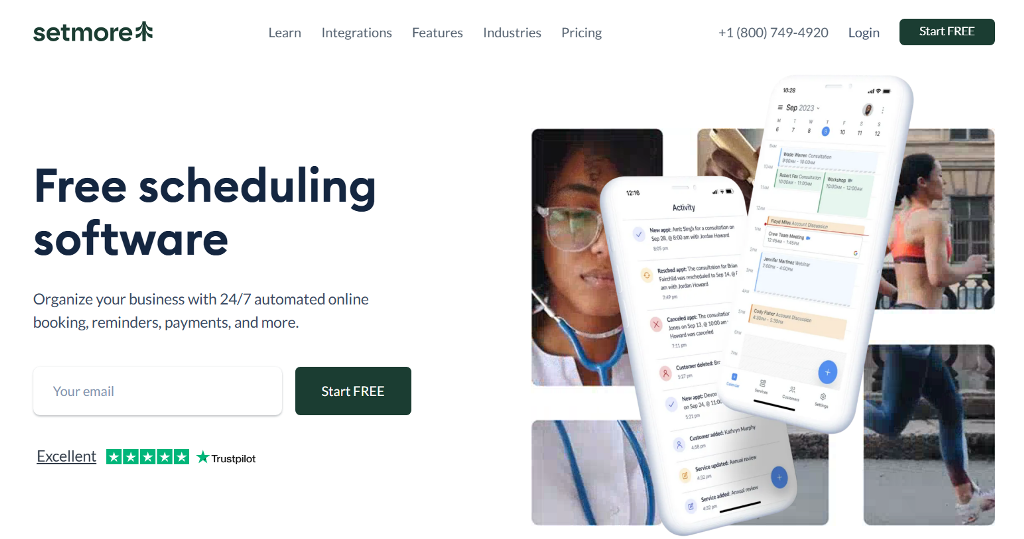
Setmore is a familiar name in scheduling—whether you’re a tutor, therapist, salon, or repair technician. You set services, staff hours, let clients pick slots, and you get reminders. It plugs into Stripe, PayPal or Square so you can take payments when clients book. The dashboard shows calendars for each staff member, and there’s support for video appointments too. According to the Setmore pricing page, they offer a Free plan for up to 4 users at $0/month, and a Pro plan at $5/user/month when billed annually (or $12/user/month billed monthly).
That said, many switch because they hit walls. Here are the friction points:
- Branding feels generic. Even with paid tiers, the booking page branding is minimal and still looks like everyone else’s.
- Payment logic is okay but not highly flexible. You may need workarounds for advanced payment setups such as deposits, split payments or custom revenue flows.
- Heavy dependence on external integrations. When you require deep workflow automation or custom databases, you end up layering multiple tools.
- Backend control is shallow. Reporting exists, but if you want full dataset exports, custom workflows or complete control over the database—you’ll run into constraints.
When you line these up, you start comparing Setmore vs other tools—asking whether you stay, switch, or build from scratch.
Top Setmore Alternatives
Not every booking tool solves the same problem. Some focus on simple scheduling links for one-person businesses; others are built for full-scale teams that need routing, intake forms, payments, or multiple service providers. When people look for Setmore alternatives, they’re usually not “shopping for a new app” — they’re trying to match software to how their business actually works.
Below is a breakdown of five options worth considering, each used by different types of service providers.
Calendly (use case: meetings & sales teams)

Best for: Teams that book calls across time zones and rely heavily on integrations.
Pros:
- Connects to Google/Outlook calendars instantly
- Routing forms help distribute calls across a team
- Polished booking links for sales, demos, onboarding
Cons:
- Many features locked behind paid tiers (workflows, SMS, routing)
- Limited branding control unless you’re on higher plans
Why pick it: Strong for organizations needing automated scheduling flows, especially when comparing Setmore vs Calendly for sales teams rather than appointment-based services.
Acuity Scheduling (use case: coaching, wellness, sessions with forms)

Best for: Coaches, therapists, and fitness trainers who need complex session logic.
Pros:
- Intake forms + HIPAA-ready options (on higher plans)
- Packages, subscriptions, and recurring sessions
- Strong payment options for paid appointments
Cons:
- More setup work than Setmore
- UI feels utilitarian rather than polished
Why pick it: Great when comparing Setmore vs Acuity for session-based businesses that need forms, subscriptions, or repeat clients.
YouCanBookMe (use case: simple scheduling + email customization)
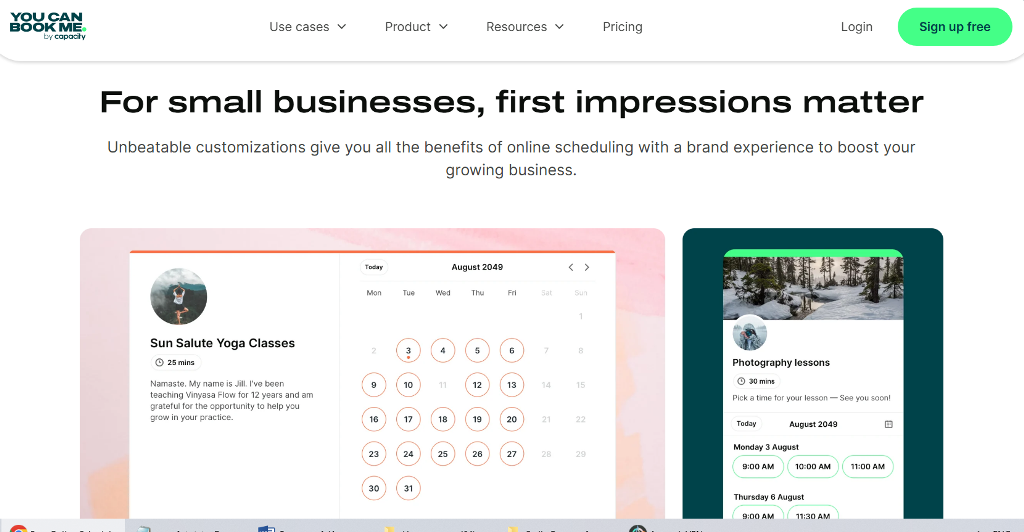
Best for: Teachers, consultants, small teams booking a lot of short calls.
Pros:
- Strong timezone handling
- Very customizable email workflows (reminders, follow-ups)
- Simple scheduling flow, easy onboarding
Cons:
- Limited advanced automation
- Not the best choice for multi-provider businesses
Why pick it: Works well for small organizations, especially those researching YouCanBookMe alternatives to upgrade later to something more robust.
Koalendar (use case: clean booking pages & low-cost upgrades)
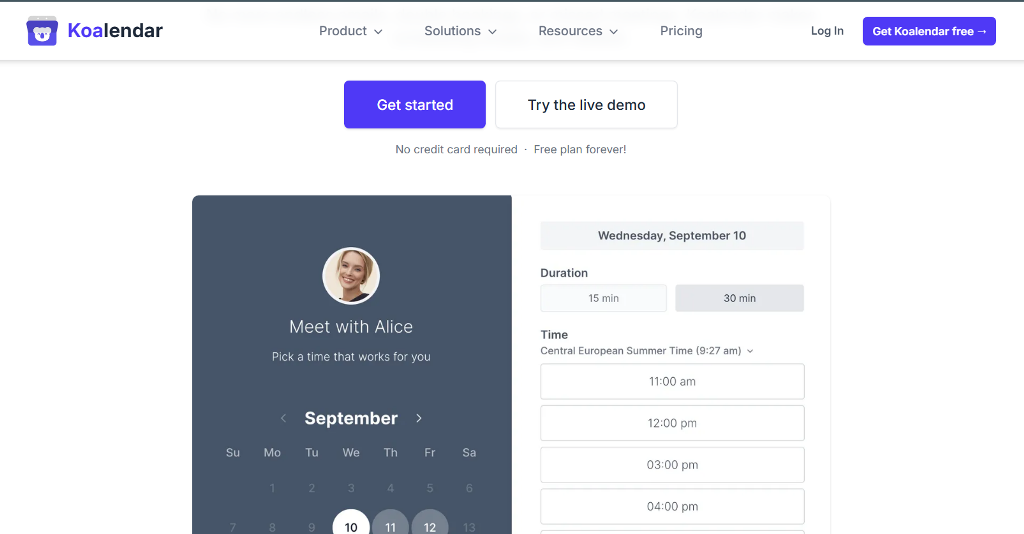
Best for: Solo creators, consultants, and small operations that want a polished booking page without a steep learning curve.
Pros:
- Simple setup, minimal onboarding
- Unlimited bookings on paid plans
- Polished public booking pages that don’t look like generic templates
Cons:
- Fewer advanced workflows for large teams
- Limited monetization features compared to Acuity or SimplyBook.me
Why pick it: A practical choice if you want something visually cleaner than Setmore but still lightweight and affordable.
SimplyBook.me (use case: beauty, wellness, local services)
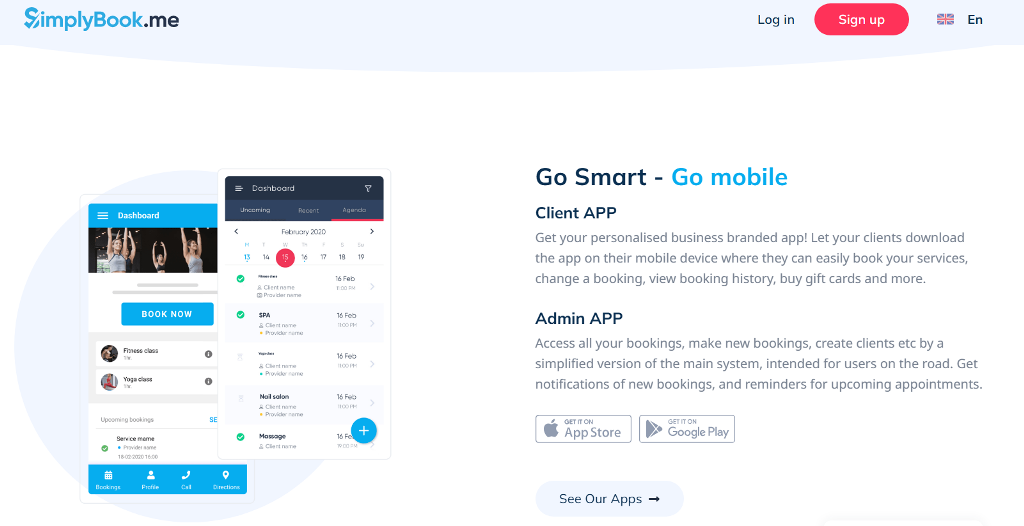
Best for: Salons, spas, trainers, clinics—anyone offering physical appointments tied to inventory and staff roles.
Pros:
- Memberships, coupons, classes, POS, gift cards
- Client app + customer login options
- Good for multi-location or inventory-based businesses
Cons:
- Interface has more menus and takes time to learn
- Feels like overkill if you only need basic scheduling
Why pick it: Ideal for service businesses that need promotional tools and staff roles, not just appointment slots.
When Switching Isn’t Enough
Most teams start comparing tools because a feature is missing—maybe they need intake forms, deposits, or better reminders. But there’s a stage where switching apps doesn’t fix the deeper issue. It happens when scheduling stops being a calendar link and becomes part of how the business actually runs.
A few situations make this obvious:
- A company operates across multiple locations and needs shared calendars, regional staff access, and internal dashboards for managers.
- A platform or mobile app wants booking built directly inside its product, not hosted on a third-party page with someone else’s branding.
- A marketplace needs provider-specific pricing, payouts, and service categories that standard scheduling tools weren’t designed to handle.
- A tutoring network charges per class, tracks attendance, and issues recurring invoices—all from the same system.
When teams hit that stage, the problems shift from missing features to missing control. You’re limited by APIs that only sync a few data fields, templates that won’t match your branding, and integrations that start stacking like patched wiring. Data stays scattered across tools, and reporting never gives a full picture of how clients move through the business.
This is where people look beyond simple Setmore alternatives and start thinking about something shaped around their own workflows. The goal becomes owning the scheduling experience end-to-end, from booking and payments to user roles and analytics, rather than bolting tools together and hoping nothing breaks on a busy week.
Build Your Own Scheduling System with Scrile Connect
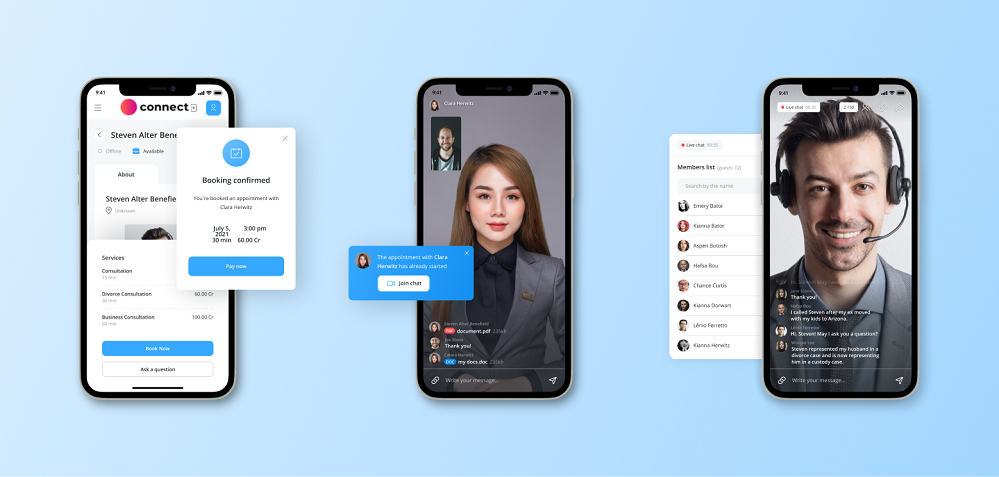
Once scheduling becomes part of how a business operates—not just something attached to it—building a tailored system starts to make sense. Scrile Connect focuses on custom development, meaning you’re not subscribing to another SaaS tool or adapting to someone else’s templates. You’re shaping a platform around your existing workflow, branding, payment structure, and internal roles.
Instead of using a public booking link hosted on a third-party domain, everything lives under your own name. Calendars, sign-ups, reminders, payments, service types, staff roles—every element is configurable. And if you outgrow a feature later, you don’t wait for a vendor’s roadmap; you just extend the system.
Businesses typically choose this route when they want booking to feel integrated, not bolted on. A few common scenarios:
- Internal booking dashboards for large teams with different permissions and reporting access
- White-label client portals for agencies or platforms that onboard multiple companies
- Paid consultation systems with deposits, session credits, or subscriptions
- Multi-vendor marketplaces where each provider sets their own pricing and availability
- Customer portals where booking ties directly into accounts, messaging, and billing
These are the situations where switching between Setmore alternatives isn’t enough, because the product itself depends on scheduling rather than simply using it.
A custom system doesn’t just manage appointments. It can connect to CRMs, payment gateways, learning platforms, chat tools, or staff dashboards—whatever the workflow demands. Scrile Connect can build scheduling into a larger ecosystem: onboarding, messaging, file sharing, recurring payments, even community features. Appointments become one part of a full product, not a standalone utility.
The goal isn’t to replace familiar tools; it’s to build something that grows as your business grows, without fighting software limits along the way.
Conclusion
No single scheduling tool works for every team. Freelancers want something quick to set up. Wellness coaches need sessions, subscriptions, and forms. Larger organizations look for routing, permissions, or revenue tracking. That’s why there are so many Setmore alternatives, each built around a different idea of how booking should work.
The real choice isn’t about which tool “wins.” It’s about how much control you need—your own branding, your own data, and the flexibility to shape scheduling around your business instead of adapting your business to software. For many teams, switching apps is enough. For others, scheduling becomes part of the product itself, and that’s when custom development starts to make sense.
If you’re building something that needs to grow without hitting feature ceilings, explore custom solutions with Scrile Connect and create a booking experience built around your workflow from day one.
Polina Yan is a Technical Writer and Product Marketing Manager, specializing in helping creators launch personalized content monetization platforms. With over five years of experience writing and promoting content, Polina covers topics such as content monetization, social media strategies, digital marketing, and online business in adult industry. Her work empowers online entrepreneurs and creators to navigate the digital world with confidence and achieve their goals.
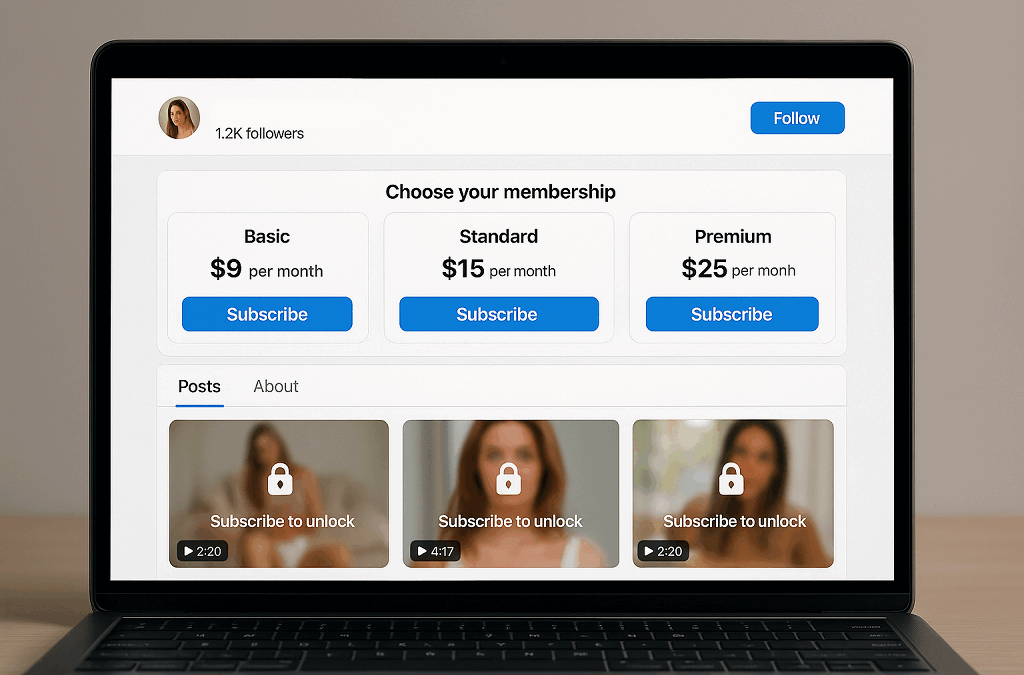
by Polina Yan
The subscription content economy is exploding. Creators are earning serious money, and fans are paying for access, not ads. It’s a shift in how content is valued — and who controls the revenue.
An OnlyFans clone isn’t a knockoff. It’s a self-owned, custom-built version of the same monetization model: monthly subscriptions, pay-per-view drops, tipping, private messages — but all under your branding. You keep 100% of what you earn. Platforms can’t ban you overnight. Your visibility doesn’t depend on algorithms.
This model works especially well in adult content, where mainstream platforms still refuse to support creators openly. But it’s also growing into adjacent spaces: fitness, coaching, fandoms — and now, the adult NFT marketplace. Tokenized content and gated drops are finding a home inside clone platforms built for flexibility.
2026 isn’t just a good time to launch. It’s the right time. The infrastructure is there. The demand is there. What’s missing is your own name on the door.
Let’s walk through how to build your own platform — and why 2026 might be the best time to do it.
Don’t Just Copy: Understand Why OnlyFans Took Off

OnlyFans didn’t go viral because of some flashy UI. It exploded because it gave creators power. They set the price, controlled the content, and got paid directly — no middlemen, no censors, no platforms pulling the plug.
The rise of OnlyFans wasn’t accidental. It matched a cultural shift: people were ready to pay for access. Real access. Unfiltered, direct, often NSFW. Fans didn’t want mass-produced, ad-funded content anymore. They wanted something personal. And they were happy to tip for it.
An OnlyFans clone needs to capture that same logic — not just clone the layout. Behind every feature is a reason it works:
- Subscriptions reward consistency
- Tips reward moments of connection
- PPV messages unlock curiosity
- Anonymity removes friction
- Exclusivity fuels retention
According to Influencer Marketing Factory report, the creator economy crossed $21 billion in revenue in 2023 — and that’s just reported income. Much of it came from platforms that embraced fan-funded content instead of fighting it.
So before you start hunting for OnlyFans clone scripts or rushing into design mockups, zoom out. Ask why this model worked in the first place. And how your platform can do it better — for your niche, your audience, and your brand.
Cloning success means cloning strategy — not just software.
Core Features You’ll Need — No Fluff
When building an OnlyFans clone, you don’t need gimmicks. You need fundamentals that work, scale, and keep both creators and fans active. Many clones fail because they either overload the site with features nobody uses or ignore the backend that makes things stable. Your goal should be to build something lean, secure, and efficient from day one.
Here’s a breakdown of the non-negotiable core features:
- Subscription tiers — Flexible pricing options let creators offer entry-level access, premium exclusives, and VIP perks. This boosts retention and gives fans choices that match their budget.
- Creator dashboards — Let creators manage content, track earnings, schedule posts, and set custom pricing without jumping through hoops.
- Payout systems — Timely, transparent, and multi-currency payment support is critical. If creators can’t get paid easily, they won’t stick around.
- Messaging and media locking — Direct DMs, pay-to-unlock messages, locked photo galleries, and video paywalls are must-haves for monetization and engagement.
- Tipping and pay-per-view — Fans love spontaneous support. A tip jar, reaction buttons, or one-time paid content helps creators make more from every interaction.
- Live streaming — Live video isn’t optional anymore. Streamed events, private calls, or group shows give creators a way to connect and earn in real time.
- Mobile-first UX — Most users will access your site via phone. The interface has to feel smooth, responsive, and intuitive on any screen size.
- Security and moderation tools — Include ID checks, content watermarks, age verification, and built-in moderation controls to avoid legal risks and protect creators.
You’re not just serving one user group. Creators need autonomy over their work, while fans need seamless access and payment options. If your site frustrates either side, you’ll lose both. Balance matters. Prioritize usability, speed, and reliability before even thinking about advanced features.
Revenue Streams to Stack

An OnlyFans clone that depends on subscriptions alone is leaving money on the table. Subscriptions are your foundation, but serious income comes from everything built around them. When creators have multiple ways to earn, retention goes up — and so does average revenue per user.
An OnlyFans-style platform only works when subscriptions are just the entry point, not the whole business model. Analysts looking at OnlyFans itself keep stressing that its power comes from combining multiple revenue mechanics, not relying on a single paywall.
“OnlyFans has matured into a global case study in how creators monetize attention. Subscriptions, PPV, bundles, and collabs form the commercial engine”
— Influencer Marketing Hub, “The Monetization Mechanics of OnlyFans”
When you design your clone, treat this as a blueprint. The more intelligently you combine subscriptions, PPV, bundles, and collabs for your niche, the more resilient and scalable your revenue stack becomes.
Let’s break down the essential revenue streams you need to bake into your build from day one:
- Pay-per-view content (PPV): One-time unlocks for premium videos or photos. Great for new followers who aren’t ready to commit to a monthly fee.
- Bundles and collections: Let fans buy sets of content at a discount. This works especially well for themed drops or behind-the-scenes series.
- Tip-to-unlock media: Hidden messages, special content, or reactions that only show after a tip. Adds exclusivity and gives fans a reason to engage.
- Private messaging fees: Charge per message or open up VIP inbox access for top-tier fans. Direct interaction is the number one reason many fans pay.
- Referral incentives: Reward users who bring in new subscribers. This builds loyalty and turns fans into brand promoters.
- Live streaming with paid interactions: Let creators stream directly from their dashboard and charge for live shoutouts, private moments, or interactive games.
- NFT content licensing: This is growing fast in the adult nft marketplace. Selling NFT-tagged videos or images with proof of ownership gives creators new monetization angles — and fans something rare to own.
- Smart contracts for royalties: Especially with NFT content, smart contracts allow creators to earn every time their work is resold or licensed.
A clone that supports all these isn’t just modern — it’s future-proof. And if you’re launching in 2026, you should be aiming for that kind of edge.
Clone Scripts vs Custom Builds
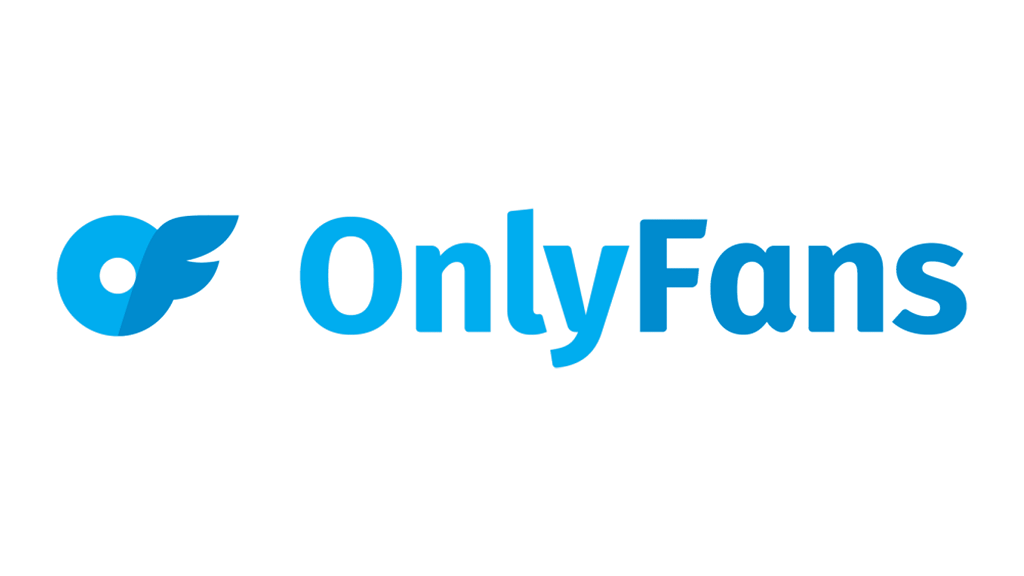
Let’s get one thing straight: a clone script is not the same as a real business infrastructure. It’s a shortcut — a prebuilt chunk of code designed to mimic another platform’s functionality, usually for a low price and with minimal effort. Most OnlyFans clones you see out there? Scripts. And while they look good on day one, the cracks show fast.
At first, a script might seem like a smart move. Fast launch, low cost, plug-and-play interface. But once creators start uploading content, fans begin subscribing, and money starts flowing — things change. Performance issues pop up. Customization hits a wall. Security gets shaky. You realize you’re stuck with someone else’s backend logic, and the only way out is a rebuild.
Why Scripts Break Under Pressure
Scalability is usually the first casualty. Scripts aren’t built for real traffic. A few thousand users can turn your site into a lagging mess. Branding is another major roadblock — try turning a cookie-cutter layout into something people remember. You won’t. And then there’s the legal headache: some clone scripts lift code too literally from the source, putting you at risk the moment lawyers start looking.
The truth is, building a lasting Only Fans clone means investing in a system that can evolve. One you can fully own, expand, and control — from payment logic to user flow. Not one that locks you into someone else’s limitations. If your business model is serious, your tech stack has to be too.
You’re not here to mimic but to monetize. And scripts don’t build sustainable ecosystems — they build headaches disguised as platforms.
Get Clear on Niche and Brand

Every successful OnlyFans clone starts with one thing — focus. Pick a clear audience and design every part of your site around them. Don’t aim wide. Aim deep. A strong niche builds stronger loyalty than a generic “all-creators-welcome” approach.
Some of the most active segments today include:
- Couples creating interactive content together
- Fetish communities looking for secure, custom content access
- Fitness creators offering exclusive plans and live coaching
- Cosplayers blending fan service with exclusive behind-the-scenes clips
Your niche defines your identity. Use it to shape your branding, tone, and feature set. Choose colors, language, and layouts that resonate with the people you want to attract.
Trust follows clarity. If users feel like the platform reflects their world, they’ll stick around. That applies to both fans and creators.
Plenty of OnlyFans clones launched without direction and vanished. One fitness-creator-focused clone tried pivoting into crypto, then gaming, then dating — and lost its core base in the process.
Don’t build something for “everyone.” Build something real for a community that needs it.
That’s exactly how sustainable creator businesses grow: not by trying to please everyone, but by serving a very specific group extraordinarily well. One of the earliest people to articulate this mindset for creators was writer and editor Kevin Kelly.
“To be a successful creator you don’t need millions.”
— Kevin Kelly, “1,000 True Fans”
An OnlyFans clone works on the same principle. If your platform helps a focused group of creators earn well from their true fans, you don’t need mass-market scale to build a serious business.
Compliance, Privacy, and Payouts

If you’re building an OnlyFans clone, legal and financial compliance isn’t something to figure out later. It’s baked into the foundation from day one.
Start with age verification. For adult platforms, this isn’t optional — it’s the law. Use trusted age-check providers and make sure content uploads follow 2257 record-keeping requirements. If you skip this, you’re one flagged video away from getting booted off your host.
Tax compliance matters, too. Creators expect accurate payouts, and governments expect reporting. Use tools that handle multi-country tax rules or integrate with services that do.
Privacy is another major trust factor. Set up secure hosting. Add masked payment systems to protect fan identities. Give creators the option to remain anonymous on payment records. These steps aren’t just for peace of mind — they directly affect signups and retention.
Now, let’s talk payouts. Adult sites get rejected by major processors all the time. Even if you’re fully legal, banks and services like PayPal might blacklist you. You need crypto-friendly gateways or merchant services that support high-risk industries.
Choose processors with clear adult industry terms. Build crypto options in from the start. Give users choices — and make sure creators get paid on time, every time.
⚖️ Clone Scripts vs. Scrile Connect
| Feature | Clone Scripts | Scrile Connect (Custom Build) |
|---|
| Ownership | No — tied to vendor’s code, branding limits | Yes — full backend control & white-label branding |
| Scalability | Struggle with high traffic, lag under load | Built to scale for thousands of users & streams |
| Monetization | Basic (subscriptions, tips) | Advanced: PPV, live streaming, pay-per-minute, NFTs, affiliate tools |
| Security & Compliance | Weak moderation & limited KYC/age checks | End-to-end: ID verification, anti-piracy, 2257 compliance |
| Payments | Risk of processor bans, few gateway options | Adult-friendly gateways + crypto integration |
| Customization | Limited templates, difficult to expand | 100% custom UI/UX, features matched to your niche |
| Long-Term Value | Short-term launch, frequent rebuilds needed | Future-proof, fully owned business asset |
Scrile Connect: Build a Clone That’s Yours
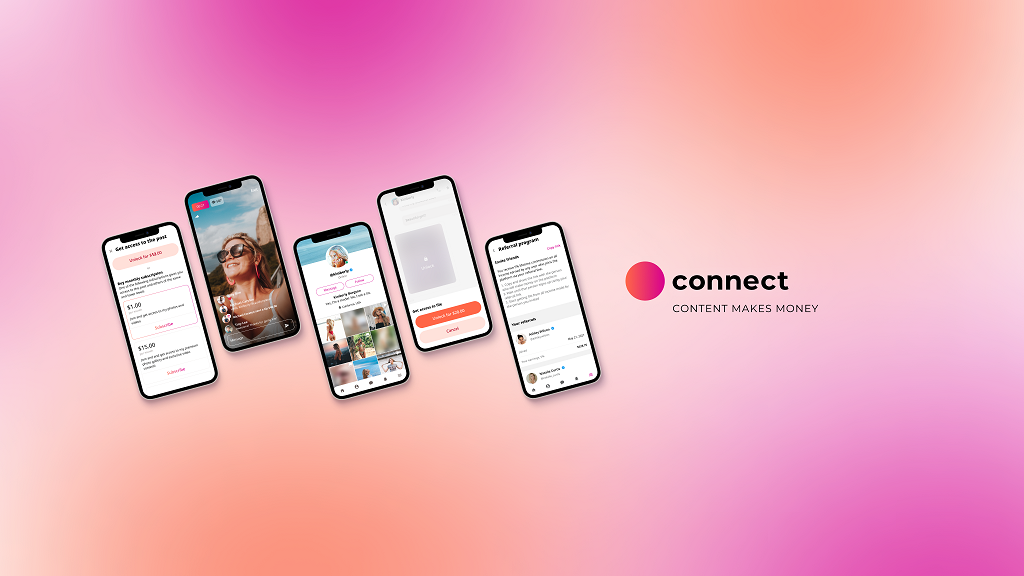
If you want to build a real OnlyFans clone — not just rent someone else’s script — Scrile Connect is the smart way in. It’s not a boxed product or a no-code app builder. It’s a development service tailored to your needs, goals, and audience — especially if you’re entering the adult industry.
Content entrepreneurs have been warning about this for years. If all your revenue depends on someone else’s product decisions, policies, or fragile script, your “business” can disappear the moment that foundation shifts.
“Do Not Build Your Content House on Rented Land.”
— Joe Pulizzi, “Find Your People, Sharpen Your Edge: Why Community + Tilt = Real Momentum”
A custom OnlyFans clone built with Scrile Connect follows the opposite logic. Instead of renting a brittle, generic script, you’re investing in a platform that you fully own, control, and can evolve with your creators and audience over time.
With Scrile Connect, you’re not bound by someone else’s branding or limited feature set. You launch under your own name, with full backend control and a frontend that looks and behaves exactly how you want. This is your site, your rules, your business.
Here’s what Scrile Connect delivers:
- Fully custom builds — not templates, but feature-rich websites crafted from scratch based on your requirements.
- Subscription systems — tiered plans, paywalls, free trials, and more, baked into your content flow.
- Built-in monetization — tipping, pay-per-minute streaming, pay-to-unlock content, and direct fan support.
- Live chat and private sessions — creator-fan engagement tools that go far beyond static feeds.
- Adult-ready infrastructure — hosting, streaming, and payment systems designed to withstand the strict policies of mainstream processors and platforms.
- End-to-end security — compliance, verification, and privacy tools for both creators and users.
- Advanced analytics — performance dashboards that show exactly what’s converting, trending, and making money.
With Scrile Connect, there are no forced revenue splits. No “Powered by” footers. No silent policy changes that break your business. What you build is yours — scalable, secure, and free from platform risk.
If you’re serious about launching an OnlyFans clone that you actually own, Scrile Connect is how you do it.
Conclusion
The creator economy keeps expanding — and fans aren’t just watching, they’re paying. Subscriptions, tips, unlockables, NFTs — these aren’t trends, they’re income streams. And yet, the platforms raking in billions? They’re rarely owned by the people creating the value.
There’s still space for new names. Not generic, overcrowded copies — but sharp, niche-focused, creator-owned platforms. Whether you’re building for fitness models, adult creators, cosplayers, or domme educators — a well-executed OnlyFans clone can become a serious business.
But if you want to actually earn — and scale — a $50 clone script won’t cut it. You need performance, stability, and something built to last.
That’s where custom development wins. When you own the site, you own the experience. You’re not stuck with a third-party roadmap. You’re free to monetize how you want — and pivot when the market shifts.
Contact the Scrile Connect team today and start building your own branded platform. No templates. No gatekeepers. Just a product that reflects your goals — and makes your revenue yours.
The next big name in the adult creator space isn’t another platform. It’s yours.
FAQ
What is an OnlyFans clone?
An OnlyFans clone is a custom-built site that works like OnlyFans — subscriptions, pay-per-view, tips, private messages — but it’s fully under your control. You run the brand, keep the profits, and set the rules.
What’s the difference between a clone script and a custom build?
A script is a cookie-cutter template. It’s fast and cheap, but limited. A custom build is made from the ground up — your design, your features, your roadmap. It scales, protects your brand, and gives you full ownership.
Can I include NFTs in my OnlyFans clone?
Absolutely. Many modern OnlyFans clones integrate with adult NFT marketplaces, letting creators mint, license, and sell digital content directly to fans. NFTs aren’t just hype — they’re another revenue stream that adds exclusivity and value.
Polina Yan is a Technical Writer and Product Marketing Manager, specializing in helping creators launch personalized content monetization platforms. With over five years of experience writing and promoting content, Polina covers topics such as content monetization, social media strategies, digital marketing, and online business in adult industry. Her work empowers online entrepreneurs and creators to navigate the digital world with confidence and achieve their goals.

by Polina Yan
Ever found yourself staring blankly at a message, struggling to find the right words? Whether it’s drafting a quick reply for a dating app, crafting a thoughtful response on a creator’s platform, or managing endless social media comments, sometimes you just need a little help. That’s where an AI answer generator steps in—offering quick, smart, and contextually relevant replies at the tap of a button.
In 2026, AI answer generators are more than just fancy text tools; they are becoming essential for creators, social media managers, and businesses looking to maintain engagement without losing a personal touch. In this article, we’ll dive into the best AI answer generators available today, showcasing tools that not only save time but also enhance the quality of interactions. Let’s explore how these AI tools can elevate your communication strategy, making every interaction more efficient, engaging, and stress-free in 2026!
What is an AI Answer Generator?
An AI answer generator is a smart tool designed to transform raw queries into well-structured, relevant answers. It acts as a virtual assistant, interpreting questions and crafting responses that feel natural and on-point. These tools are particularly valuable for streamlining communication on creator websites, dating platforms, social media, and even adult websites, where maintaining engagement and providing quick replies are crucial.
At its core, an AI answer generator relies on technologies like Natural Language Processing (NLP) and machine learning. These technologies analyze the input, understand context and intent, and generate answers that match the tone and style of the platform. Whether it’s an AI question answer generator or a discussion post reply generator, the goal is to deliver responses that enhance user interactions and save time. And with options like free AI answer generators, even small platforms can leverage this technology to boost their efficiency and maintain a vibrant online presence.
Benefits of Using AI Answer Generators

AI answer generators offer a powerful set of advantages, making life easier for creators, influencers, social media managers, and digital businesses:
- Time Efficiency: With an answer generator, hours of typing and overthinking can be reduced to mere seconds.
- Consistency and Accuracy: Instead of manually crafting each response, an AI generator answers with the same tone and precision, reducing the chance of errors and keeping communication on-brand.
- Real-World Impact: A dating platform, for instance, integrated an AI answer generator to manage repetitive user queries. The result? A 40% boost in response speed and happier users who received instant, accurate answers.
- Versatility Across Use Cases: For creators, an AI question answer generator can help engage audiences by generating thoughtful replies to comments. Social media managers can use AI generated answers to handle large volumes of messages without losing the human touch.
Top 5 AI Answer Generator Tools in 2026
When it comes to finding the best AI answer generator in 2026, there are plenty of options on the market, each offering unique features and benefits:
ChatGPT

ChatGPT by OpenAI continues to lead the pack as a versatile and powerful AI answer generator. Built on the advanced GPT-4 architecture, ChatGPT excels at generating smart and contextually accurate responses for everything from discussion posts to chat interactions and customer support queries.
One of the standout features of ChatGPT is its ability to maintain a consistent voice while adapting to different communication styles. For example, a content creator managing a vibrant online community can use ChatGPT to generate thoughtful replies to fan comments, keeping engagement high without feeling repetitive or automated. The tool’s flexibility also makes it perfect as an AI discussion post generator in real-time, whether through a social media chat or a Q&A forum on a creator’s website.
Jasper AI
If you’re looking for a polished and professional answer generator, Jasper AI is a top choice, particularly for marketing and content-driven platforms. Jasper is designed to create well-structured and articulate responses, making it an ideal fit for scenarios where maintaining a specific tone or brand voice is crucial.
A practical example of Jasper’s use is on a creator’s website where maintaining engagement with fans is essential. Jasper can help generate thoughtful replies to fan inquiries, ensuring responses are not only quick but also meaningful and brand-consistent. Whether it’s responding to questions on a blog, managing comments on a video platform, or creating tailored replies for email interactions, Jasper’s AI capabilities can significantly enhance communication efficiency.
Writesonic
Writesonic is known for delivering quick and creative answers, making it an excellent tool for social media managers and content creators. This AI answer generator free option shines in generating witty and engaging responses, particularly useful in fast-paced environments like social media where maintaining a brand’s voice consistently is key.
A real-world scenario where Writesonic excels is in handling high volumes of social media comments. Whether it’s responding to followers on Instagram or managing conversations on a dating app, Writesonic generates replies that feel genuine and on-brand.
Claude AI
Claude AI, developed by Anthropic, is a relatively new player in the AI answer generator market but has quickly gained traction for its conversational and context-aware responses. Unlike many AI tools, Claude focuses on generating answers that feel human and maintain a natural flow of conversation.
A notable feature of Claude AI is its ability to understand nuanced queries and provide detailed, thoughtful answers. This makes it an ideal choice for platforms that prioritize engagement and authenticity, such as dating apps, creator websites, and social media forums.
Tidio AI
For small businesses and startups, Tidio AI offers a practical and cost-effective solution. Tidio specializes in automating responses for customer support and basic interaction management, making it a smart choice for e-commerce sites and small digital communities.
Tidio’s easy integration with platforms like Shopify and WordPress makes it particularly useful for businesses that need a straightforward and affordable answer generator without compromising on quality or functionality.
Why Scrile Connect’s Answer Generator is the Best Choice

Scrile Connect offers a unique approach to AI-generated answers, especially for niche markets like creator websites, dating platforms, social media, and adult content sites. Instead of offering a one-size-fits-all solution, Scrile Connect provides fully customizable tools that adapt to specific communication needs.
Its standout feature is contextual understanding, analyzing past interactions to deliver personalized responses. This is ideal for platforms where audience connection is key—such as generating thoughtful replies on adult fan sites or managing engaging chats on dating apps.
Scrile Connect also supports dynamic conversation phrases, allowing seamless transitions from casual chats to targeted sales interactions or more intimate exchanges. This adaptability helps maintain engagement and authenticity across all types of interactions.
For creators looking to monetize their AI tools, Scrile Connect offers the flexibility to build bespoke platforms, enabling direct sales of AI-generated answers, art, or other digital assets. This approach ensures full control over branding and revenue while fostering a dedicated community around your unique offerings.
Conclusion
Scrile’s AI answer generator offers a dynamic and customizable solution for enhancing communication strategies. If you’re ready to boost engagement and streamline responses with intelligent, human-like answers, explore how Scrile’s bespoke AI tools can elevate your platform’s communication game today!
Polina Yan is a Technical Writer and Product Marketing Manager, specializing in helping creators launch personalized content monetization platforms. With over five years of experience writing and promoting content, Polina covers topics such as content monetization, social media strategies, digital marketing, and online business in adult industry. Her work empowers online entrepreneurs and creators to navigate the digital world with confidence and achieve their goals.
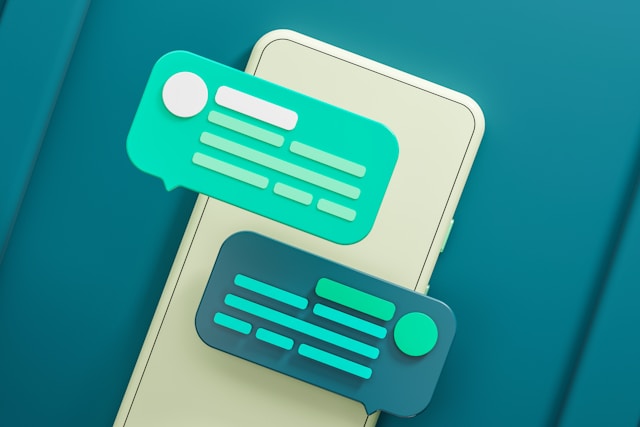
by Polina Yan
Picture a world where every response is just a click away—no more typing, just choosing. This is no longer just a concept; it’s a reality brought to life by AI reply generators. These powerful tools are revolutionizing communication across a spectrum of platforms, from customer service to social media. With the automation of response, AI reply generator enhances efficiency and ensure uniformity of tone and quality regardless of the volume of questions.
With the year 2026 in action, AI response generators are not only getting intelligence but also interwoven deep into our routine communication requirements. This article explores the best AI reply generator platforms ruling the current market. The tools are important for any one wanting to automatize their communicative processes since they provide remedies that are not only quick but also context-dependent to preserve that personal element of so much significance in digital engagement. Come along with us as we discover how these AI reply generator tools are turning routine interactions into vibrant exchanges, thus redefining the future of digital communication.
Top 7 AI Reply Generators in 2026
| Tool | Best For | Key Strengths | Limitations |
|---|
| ChatGPT (OpenAI) | General use & customer support | Human-like replies, wide integrations, adaptive tone | Subscription required for advanced use |
| Jasper AI | Marketing & branded messaging | Consistent brand voice, strong customization | Suited more for teams than casual users |
| Planable Free AI Reply Generator | Social media | Easy to use, affordable (freemium), cross-platform | Limited to social-focused workflows |
| Zendesk Answer Bot | High-volume support | Native to Zendesk, fast ticket resolution | Locked to Zendesk ecosystem |
| Intercom Resolution Bot | Customer experience | Learns & improves over time, seamless Intercom fit | Requires Intercom subscription |
| Hootsuite Insights | Social media managers | Always-on monitoring + automated replies | Narrow focus on social media |
| ManyChat | Websites & social media chat | Customizable flows, simple setup | More automation than nuanced replies |
Understanding AI Reply Generators
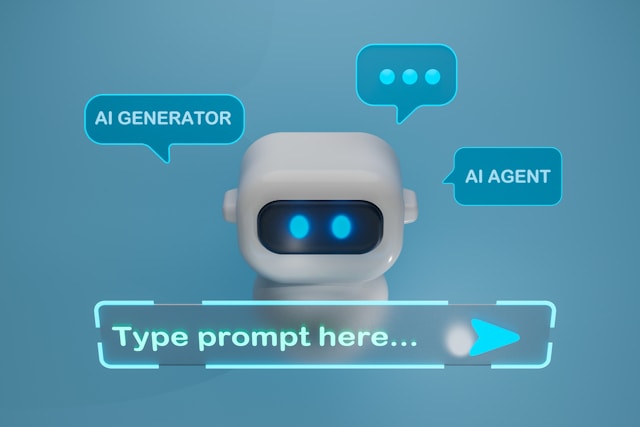
An AI reply generator is a highly advanced tool that uses artificial intelligence to automatically generate responses to messages on different digital platforms. Using advanced technologies like Natural Language Processing (NLP) and machine learning, these generators scan incoming text to create contextually relevant replies.
Technology Explained
NLP is at the heart of an AI reply generator. It is the branch of artificial intelligence that deals with the interaction between humans and computers in natural language. It aims to read, comprehend, and interpret the human languages in a way that is beneficial. Machine learning adds to this by allowing the system to learn from past interactions and therefore improve the accuracy and usability of responses with time. This technological synergy enables the AI to understand nuances in language, interpret user intent, and generate replies that are not only accurate but also appear naturally conversational.
Versatility in Application
AI reply generators are increasingly becoming a staple in several sectors due to their ability to enhance communication efficiency. In customer support, they provide immediate responses to common inquiries, reducing wait times and freeing up human agents for more complex issues. For email automation, these tools help manage large volumes of incoming mail, ensuring that no customer feedback or query goes unanswered. In the realm of instant messaging, AI generators can maintain continual engagement with users, providing timely and relevant content that keeps conversations alive and users engaged.
Businesses across different sectors now view AI response generators as more than just a means to manage communication but as a strategic weapon as part of providing an enhanced customer experience and process optimization. From streamlining customer interaction in retail, managing patient inquiries in healthcare, to enabling guest requests in hospitality, these AI platforms are transforming how businesses engage in communication.
Through diverse uses, AI text reply generator ensures that each response is not only fast but also in answer to the context of the conversation, as per the tone and urgency of the question. As they continue to evolve, they will be the key drivers in shaping the future of automatic digital communication, making the interactions more human and less mechanical.
Benefits of AI Reply Generators

AI reply generators are transforming the landscape of digital communication across various industries by enhancing the efficiency, personalization, and cost-effectiveness of responses. These intelligent systems are not just tools but essential partners in managing the ever-increasing demands of modern communication.
Efficiency in Communication
One of the standout benefits of AI reply generators is their ability to enhance both the speed and accuracy of communication. By automating responses, organizations can handle a larger volume of inquiries without compromising on the quality or timeliness of the response. This is particularly crucial in environments like customer service, where quick and accurate responses are directly correlated with higher satisfaction rates. AI technologies ensure that each reply is not only prompt but also relevant and precise, minimizing misunderstandings and the need for follow-up messages.
Personalization at Scale
AI reply to text software excel in delivering personalized communication at scale. By analyzing user data and previous interactions, these systems tailor their responses to the specific context and preferences of each user. This capability allows businesses to maintain a personal touch even when communicating with thousands of customers simultaneously. Personalization fosters a stronger connection between brands and their clients, enhancing customer loyalty and engagement.
Cost Reduction
Implementing AI text message reply generators can significantly reduce operational costs by decreasing the reliance on large human response teams. Automating routine inquiries and responses allows human agents to focus on more complex and nuanced customer needs, optimizing the workforce and reducing overhead. Additionally, AI systems operate continuously without the need for breaks, sick leaves, or vacations, providing around-the-clock service that would be costly to replicate with human labor.
By integrating tools like an AI message reply generator and AI message responder, organizations can achieve a high degree of operational efficiency, enhancing their ability to respond quickly and effectively to customer inquiries and feedback. This not only improves the operational workflow but also contributes to a more streamlined, cost-effective business model.
Features to Look for in AI Reply Generators
When choosing an AI reply generator, it’s essential to pay attention to features that will maximize its utility and make it seamlessly integrate with your current systems. Some important features to keep in mind are:
Ease of Integration
- Compatibility with Systems: Make sure the tool can integrate perfectly into your existing software framework.
- API Availability: Look for solutions that offer robust APIs, allowing for easy integration with various platforms, including CRM systems, social media, and internal communication tools.
Security and Privacy
- Data Handling: Choose AI tools that prioritize data security and comply with relevant regulations such as GDPR.
- User Privacy: The tool should have strong privacy protections in place to safeguard user information from unauthorized access.
Customization Capabilities
- Contextual Adaptability: It should have the ability to understand and adapt responses based on the conversation’s context and the company’s branding.
- User Preferences: The AI should be able to learn from interactions and adjust its behavior and responses according to user preferences.
Reliability
- Performance Consistency: Look for a reply generator that performs consistently under different loads and can scale according to your business needs.
- Uptime Guarantees: Ensure the provider offers reliable uptime statistics to keep your communications smooth without interruptions.
Top 7 AI Reply Generators in 2026
The age of AI messaging is yet to mature, and some leading reply generators are leading the way in 2026. All these reply generators bring something special to the table in reply automation, customer interaction, and enhancing the flow of communication. Some of the best options include:
ChatGPT by OpenAI
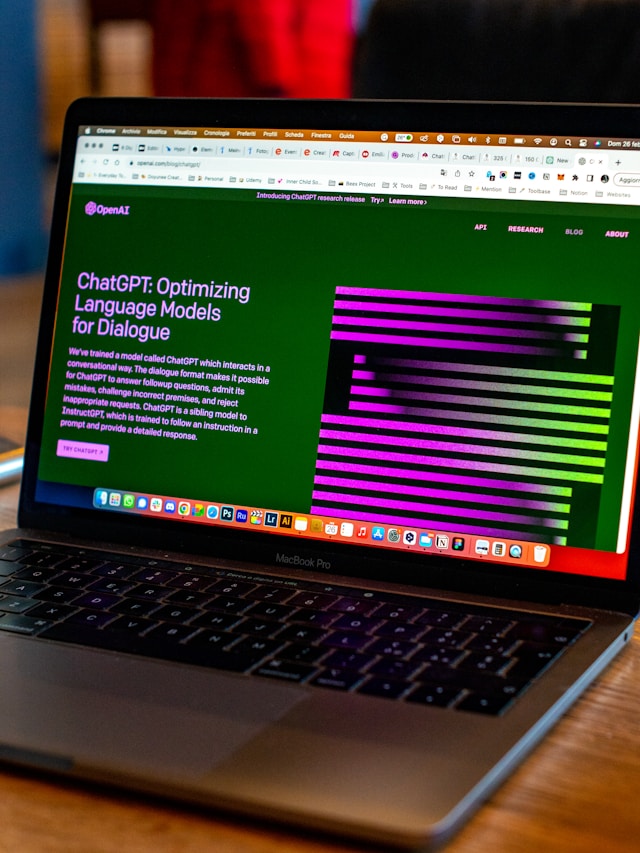
OpenAI’s GPT-4o is still a giant in AI communication. It is able to perform complicated language tasks with no trouble, and as a result, is suitable to an incredibly broad range of applications—anything from customer support chats to getting into complicated, context-dependent conversations. With sophisticated-level algorithms, it is able to receive and provide responses highly similar to humans, and as a result, interactions feel all the more authentic.
Jasper AI
Tailored specifically for marketing communications, Jasper AI specializes in generating engaging, personalized responses. Jasper AI is an excellent resource for business firms that aim to grow their online marketing because it incorporates advanced machine learning models which assist in creating responses most engaging to customers, interact more, and help business firms to form deeper customer connections.
Planable Free AI Reply Generator
Known to be simple and user-friendly, Planable makes it possible for business to automate responses across multiple platforms. It is a social media interaction specialist with functionalities that allow businesses to communicate with their audiences with a constant and fresh stream of communications. The app is available on a freemium basis and is ideal for business to achieve better responsiveness without the load of huge costs.
Zendesk Answer Bot
Zendesk Answer Bot is integrated into Zendesk’s customer support suite and enhances the support experience with quick, machine-driven responses. It is user-sensitive and provides targeted information that completes the solution within a brief period of time and therefore reduces human agents’ workload and improves customer satisfaction levels. It is invaluable in high-volume environments where time is key in maintaining service levels.
Intercom’s Resolution Bot
Intercom’s Resolution Bot excels in automating customer interactions, efficiently managing routine inquiries which allows human agents to concentrate on more complex support issues. The bot is designed to execute flawlessly alongside Intercom’s communication platform, providing users with a smooth and seamless experience. It also has advanced learning algorithms that enable it to get smarter by the day, making it a worthwhile investment for long-term interaction.
Hootsuite Insights
Hootsuite Insights is for social media managers who have to be present actively on platforms with no human touch. The AI-powered tool examines interactions and reacts automatically in a way that all communications are responded to in a timely and appropriate manner. It is particularly suitable for brands that have to be present online at all times, and it offers insights and automatic features that help make conversations stimulating and engaging.
ManyChat
ManyChat offers extensive customization for automated chat solutions that work across both websites and social media platforms. It allows businesses to craft a personalized chat experience for customers, enhancing interaction through tailored dialogues. With its user-friendly interface and powerful automation capabilities, ManyChat helps businesses of all sizes improve their customer engagement and drive conversions through effective communication strategies.
Each of these AI reply generators brings unique benefits to the table, from enhancing customer service efficiency to driving engagement on social media. As businesses continue to adapt to the digital-first communication landscape, these tools provide essential solutions to meet a variety of communicative needs effectively.
Why Choose Scrile AI for Custom Reply Generations
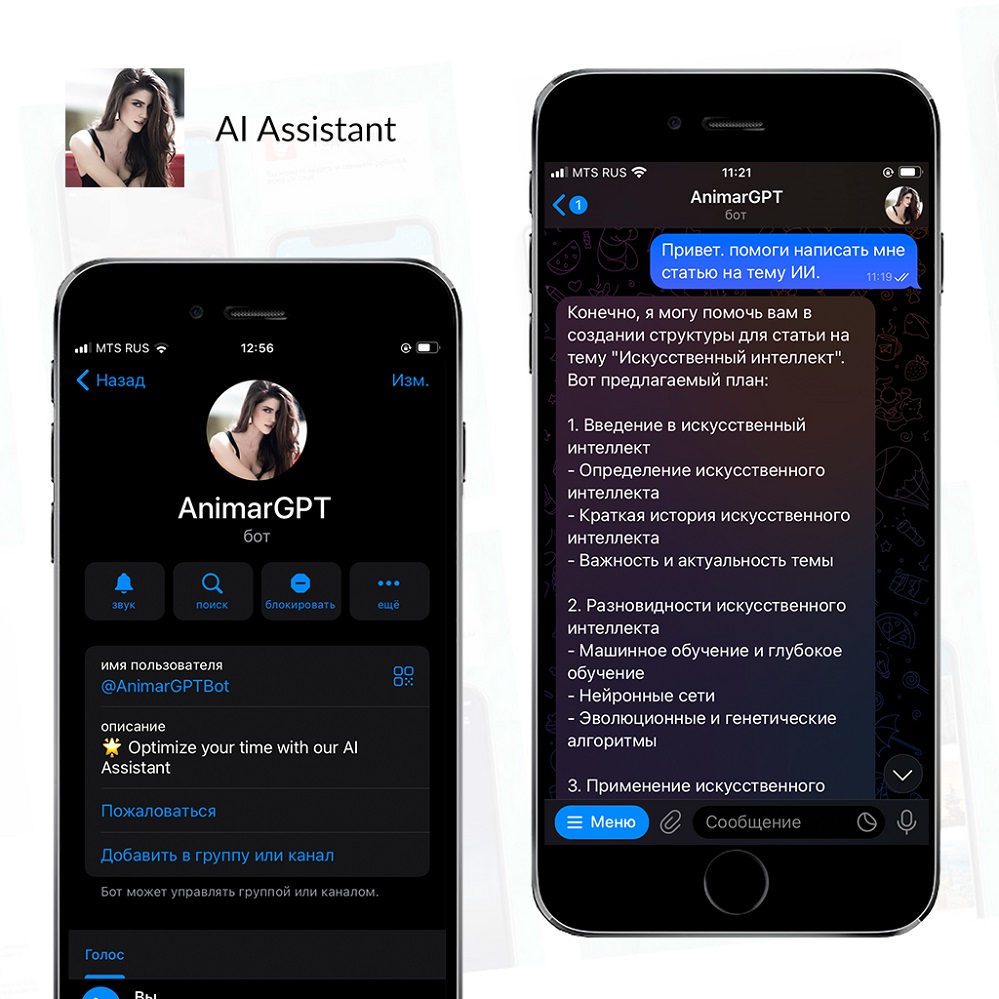
Scrile AI distinguishes itself in the crowded field of AI communication tools by offering highly customized solutions tailored to the specific needs of each client. Unlike one-size-fits-all products, Scrile AI understands that each business has unique requirements and challenges. Here’s why Scrile AI stands out:Generic AI Reply Generators vs. Scrile AI (Custom-Built)
| Option | Branding & Voice | Adaptability | Integrations | Best Fit |
|---|
| Generic Reply Generators | Fixed templates, limited tone control | Pre-set features, evolve only via vendor updates | Usually tied to specific ecosystems | Individuals, SMBs |
| Scrile AI (Custom Solution) | Fully aligned with your brand | Learns, evolves, and adapts to sector-specific needs | CRM, social, dating, tech support, custom APIs | Businesses & platforms needing ownership |
Custom Solutions
- Tailored Implementation: Scrile AI designs reply generators that integrate seamlessly with your existing workflows, ensuring that all solutions align with your business processes and communication strategies.
- Flexible Configurations: Whether you need a system that supports casual conversational tones for social media or professional responses for customer support, Scrile AI can adjust its technologies to match any required tone and function.
Industry Expertise
- Social Media Savvy: Scrile AI has extensive experience in creating systems that can handle the fast-paced and ever-changing demands of social media platforms, helping brands maintain an active and engaging presence online.
- Dating Platform Dynamics: For dating platforms, creating genuine and engaging interactions is crucial. Scrile AI’s systems are crafted to manage sensitive and nuanced communications effectively.
- Tech Support Proficiency: In tech support, speed and accuracy are paramount. Scrile AI develops solutions that enhance response times and improve the accuracy of technical support replies, ensuring customer satisfaction and loyalty.
Benefits of Using Scrile AI
- Scalability: No matter the size of your business, Scrile AI’s solutions scale to meet your growing needs without losing the personal touch that distinguishes your brand.
- Integration Capabilities: Easy integration with existing CRM systems, social media platforms, and other digital communication tools makes Scrile AI a versatile partner in digital communication.
- Data Security: Scrile AI prioritizes your data’s security, implementing robust measures to protect all communications and user information.
Choosing Scrile AI means investing in a solution that adapts to your needs, backed by expertise across various sectors. This approach ensures that your AI-driven interactions are as effective and natural as possible, enhancing your brand’s digital communication strategy.
Conclusion
AI reply generators have revolutionized communication, offering tailored responses that enhance efficiency and engagement across various platforms. By automating routine interactions, these tools allow organizations and individuals to focus on more complex and creative tasks, significantly improving productivity and interaction quality. Consider how integrating an AI reply generator like those offered by Scrile AI could transform your communication strategies. Scrile AI excels in providing customized solutions that adapt to specific needs, ensuring your communications are not only effective but also uniquely yours. Embrace the future of communication by exploring Scrile AI’s innovative solutions today.
Polina Yan is a Technical Writer and Product Marketing Manager, specializing in helping creators launch personalized content monetization platforms. With over five years of experience writing and promoting content, Polina covers topics such as content monetization, social media strategies, digital marketing, and online business in adult industry. Her work empowers online entrepreneurs and creators to navigate the digital world with confidence and achieve their goals.

































































